Report

1. Asia-Pacific private equity: China slumps, exits fall
After roaring ahead in 2017 and 2018, Asia-Pacific private equity (PE) investment declined year-on-year as the region’s largest market, Greater China, slumped. There, the boom that produced record deal value for two years running ended abruptly: Deal activity and exits plunged, pulling down the region’s performance. In all other geographies, by contrast, investment grew or was on par with the average of the previous five years.
Domestic factors played a large role in China’s reversal. Real GDP growth in the second half of 2019 slowed to 6%, the lowest rate since the first quarter of 2009, in the midst of the 2008–2009 recession. The ongoing low level of renminbi-based fund-raising undercut investment activities by reducing dry powder. Ongoing trade tensions with the US and social unrest in Hong Kong also undermined the economy and investor confidence. Bain’s 2020 Asia-Pacific private equity survey, conducted with 175 senior market practitioners, shows that macro softness was the No. 1 worry for PE funds focused on Greater China.
Beyond the contraction in Greater China—and perhaps more worrying—the sharp drop in exits across the region meant that cash flow for limited partners (LPs) in late 2018 and 2019 was negative for the first time since 2013. General partners (GPs) already had trimmed their portfolios in 2018 when exit values hit a record high, but an uncertain macroeconomic outlook, tepid M&A activity and an erratic stock market also discouraged funds from pursuing exits.
Despite warning signals, several positive trends stood out. Solid investment growth in other markets helped maintain Asia-Pacific’s heavyweight status in the global private equity market (see Figure 1.1). The asset class also remained a popular source of capital in the region. It made up 17% of the Asia-Pacific merger-and-acquisition (M&A) market, slightly down from the previous year, but up from an average 14% in the previous five years.
Importantly, returns remained strong, with the top quartile of Asia-Pacific-focused funds forecasting a net internal rate of return (IRR) of 16% or higher, and private equity outperformed public-market benchmarks by at least six percentage points across 1-, 5-, 10- and 20-year periods.
Asia-Pacific now represents a quarter of the global PE market

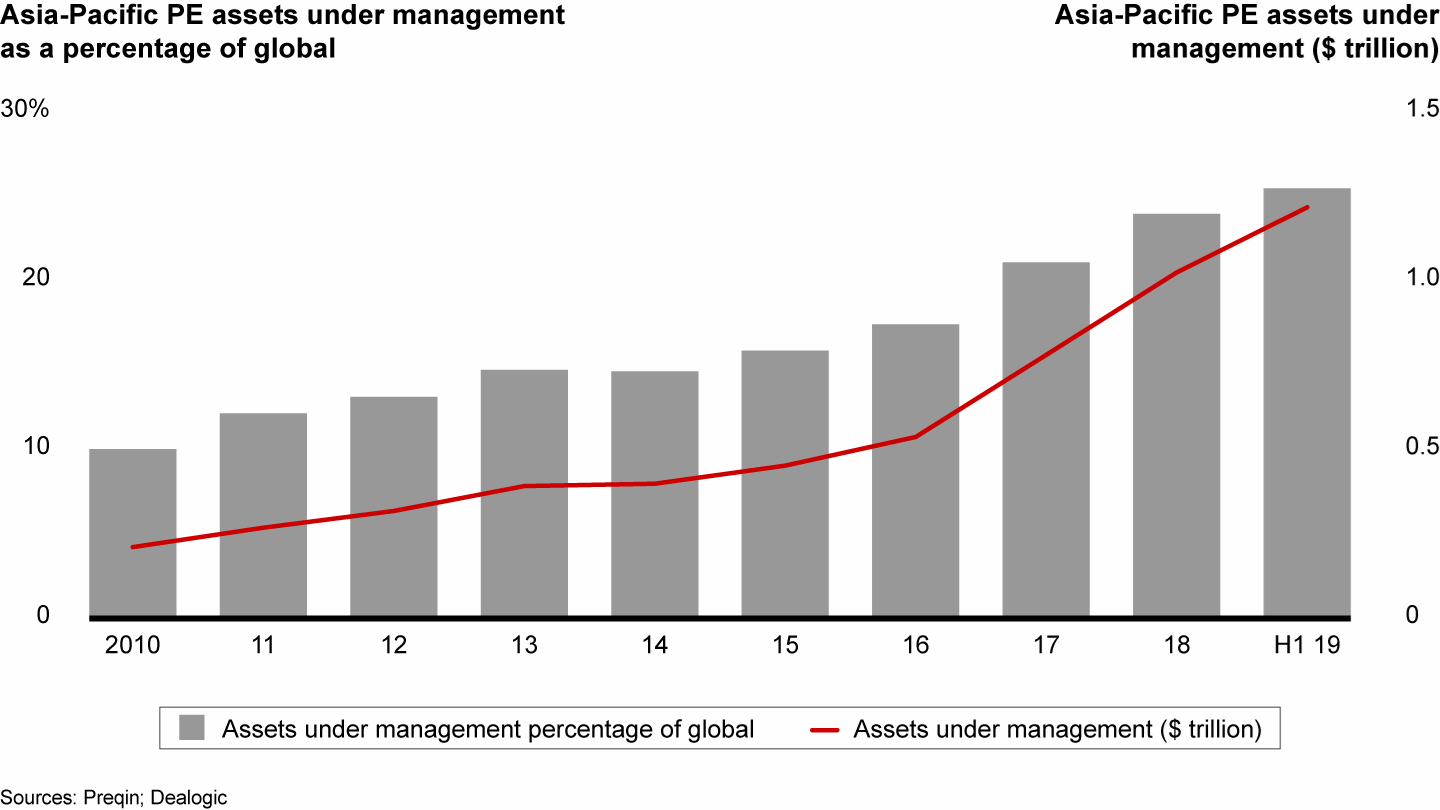
Looking forward, the region’s general partners face a broad set of challenges. Widespread uncertainty in financial markets, exacerbated by the coronavirus outbreak in China, trade frictions and macroecononic risk paint a more sober picture for the coming year. Any one of those factors could trigger serious economic and social imbalances in the coming decade, changing the investment outlook for countries or regions. As investors weigh those risks, many are becoming more cautious.
But uncertain times also create opportunities for those who are well-prepared. Leading funds are anticipating disruption and targeting sectors likely to thrive in a downturn. Bain research shows that in hard times, the performance gap between winners and losers widens. Top performers adjust their strategies before the market shifts, increase their control over deals and manage their portfolios more actively. Reducing risk while redoubling their focus on opportunities helps GPs outperform even in an unpredictable market.
As PE funds seek out new pockets of growth, many are eying Internet and tech-related assets. Though investors worry about the risk of a market correction, the sector offers faster-than-average growth and was widely recession-resistant during the last global financial crisis. But given the record high prices for these assets, ferreting out smart investments requires a special set of skills and capabilities. Winning GPs are investing in talent, building partnerships, honing their approach to deal assessment and ensuring companies with new technologies have a path to commercialization. In section 3, we’ll look more closely at how leading PE funds are navigating a riskier investment landscape, and their changing focus within the Internet and tech sector.
2. What happened in 2019?
Asia-Pacific’s private equity markets went their own way in 2019, with diverging tales of growth and contraction. Greater China was hit hard by macroeconomic uncertainty and a reduction in megadeals, while investment activity flourished in most of the other markets.
With Asia-Pacific’s powerhouse market down, investment decelerated to $150 billion. Exits took a hit across the region and sank 43% from a record high in 2018. Overall, fund-raising in 2019 tumbled 45% from the historical five-year average. Restrictions on renmimbi-denominated funds continued to hamper activity in China (see Figure 2.1). And with a record $388 billion in dry powder available, GPs didn’t feel pressure to raise new funds.
The Asia-Pacific PE market slowed in 2019

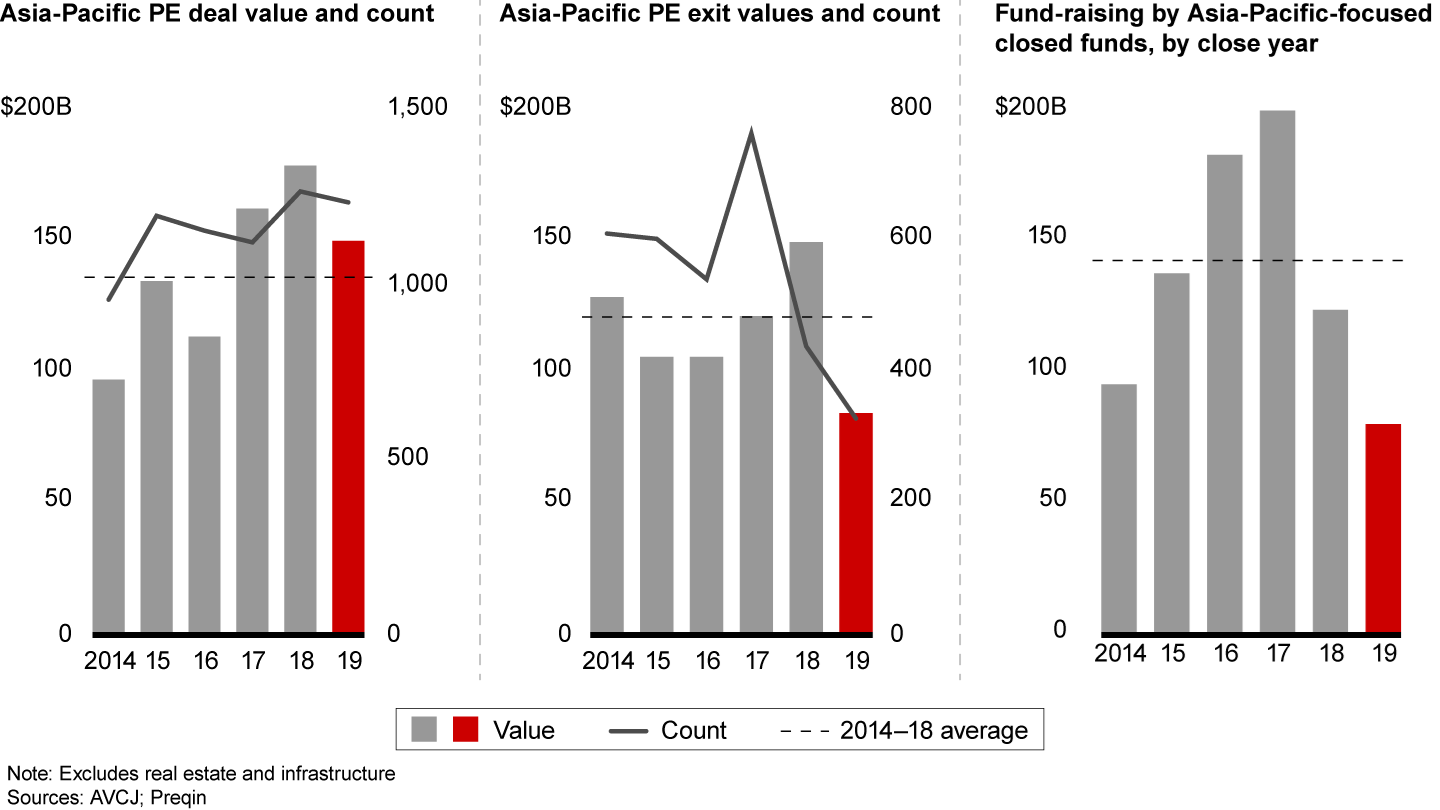
Deals: China and its new economy contract
After historic highs in 2017 and 2018, Asia-Pacific deal value slumped 16% in 2019 to $150 billion, but was still 9% higher than the average annual $137 billion in the five previous years. The average deal size was $122 million, on par with the five-year average.
Greater China suffered the biggest drop in the region’s deal activity. The decline in renminbi-based fund-raising was a key factor undercutting investment. Total deal value fell below the levels of the previous two years and was 16% lower than the annual average for the previous five years. By contrast, investment value in India, the second-largest market in Asia-Pacific, was 29% higher than in 2018 and 88% higher than the previous five-year average (see Figure 2.2). Despite a softening economy, strong interest from global and local investors in India’s burgeoning Internet and technology sector buoyed deal value.
The four remaining Asia-Pacific markets performed solidly in 2019. Deal value in South Korea outperformed the 2014-to-2018 average by 36%; it rebounded 18% in Australia–New Zealand and rose 19% in Southeast Asia (although it declined slightly from the year before). By contrast, deal value in Japan was slightly below the past five-year average and 144% above 2018, when investment activity fell sharply, the result of fewer large deals and investors’ inclination to hold high-quality assets instead of selling in a difficult market.
Greater China deal value fell abruptly, but other markets expanded

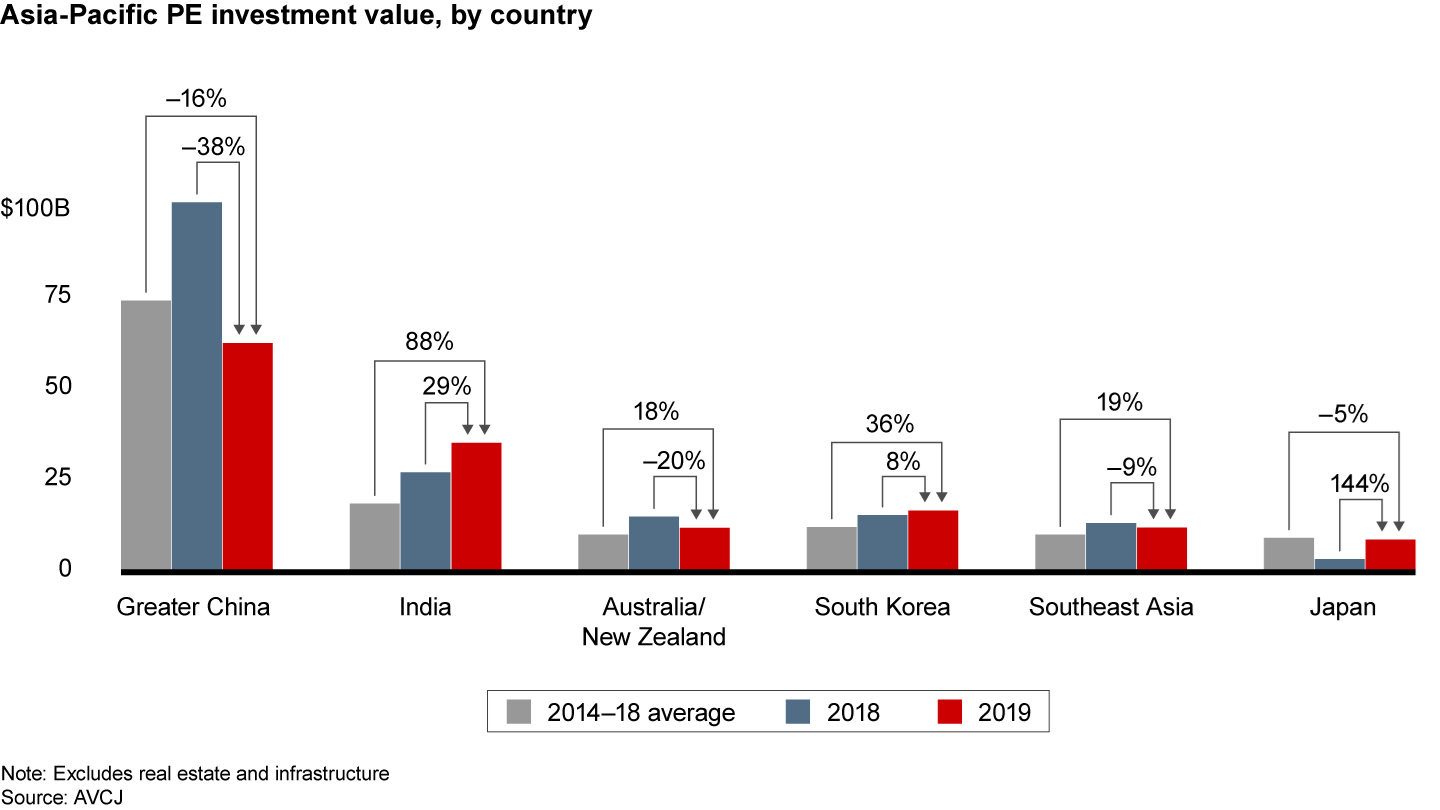
Investors again preferred teaming up on deals, a trend called deal clubbing. The average number of investors per deal was 3.2, on a par with 2018 and higher than 2.6, the average for 2014 to 2018. Joining forces gives investors greater access to a larger pool of deals and mitigates the risk.
For the eighth year running, the Internet and technology sector attracted the largest share of capital. However, for the first time since 2017, investment slowed in the sector and made up 42% of all investment value, compared with 53% the previous year. In a dramatic reversal, the number of Asia-Pacific megadeals in the Internet and tech sector valued at $1 billion fell to 10, down 50% from 2018. The decline in renminbi fund-raising was partly responsible for this drop. By contrast, investors had a strong appetite for consumption-driven sectors, including consumer products and healthcare, which rose from the prior five-year averages by 170% and 66%, respectively, buoyed by a rising middle class in China, India and Southeast Asia (see Figure 2.3).
Asia-Pacific Internet and technology investment declined for the first time since 2016, while consumer-related sectors flourished

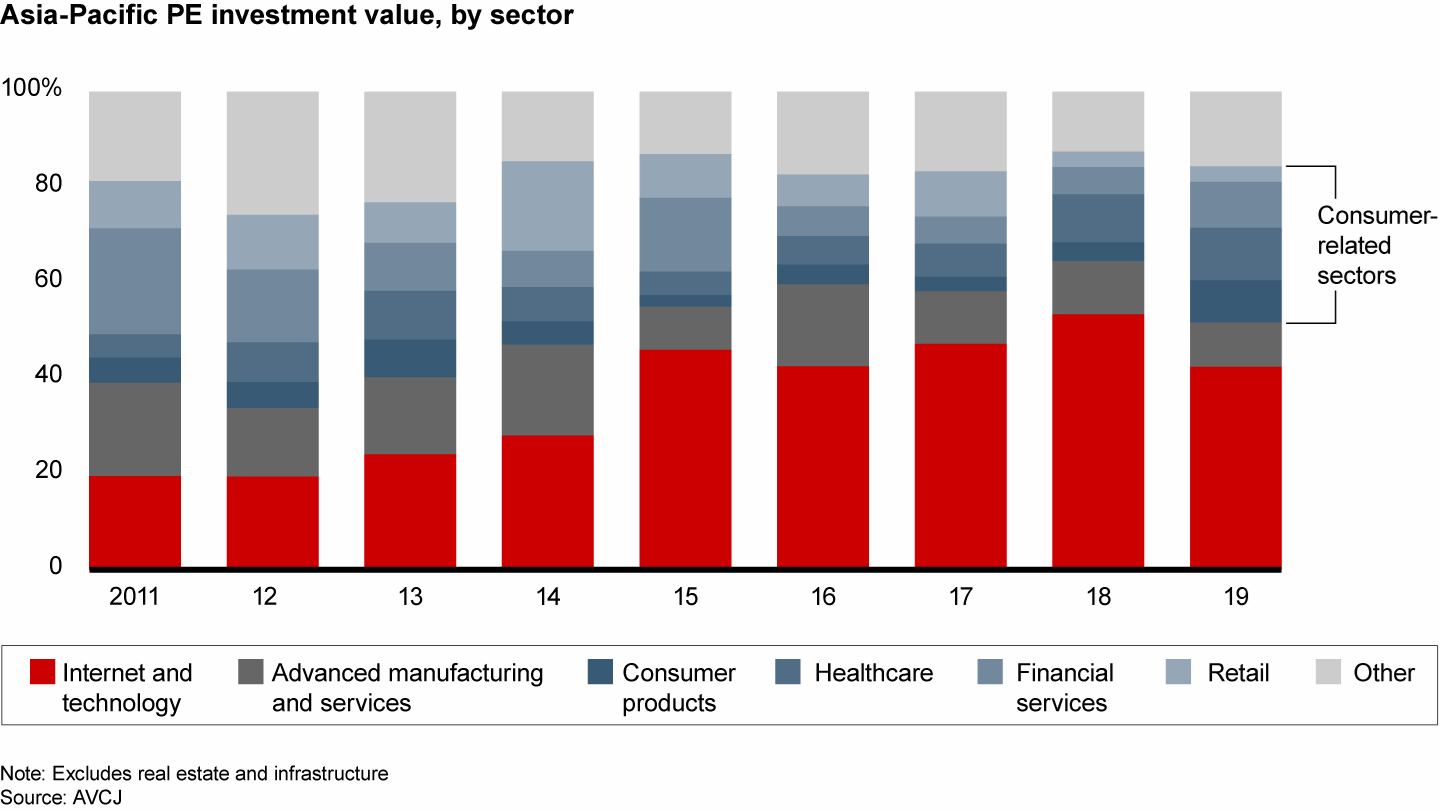
While investors prefer deals that give them control over the way the company operates, locking in a majority stake isn’t easy in Asia-Pacific. As in 2018, buyouts accounted for only a quarter of the market. Growth deals again were the largest segment, making up 62% of deal value. GPs are still looking for a path to control in situations where they have a minority stake, securing board seats or decision rights for the most important decisions. Bain’s 2020 Asia-Pacific survey shows 38% of minority deals included a path to control in 2019, and investors expect that proportion to increase to about 50% in the next two to three years (see Figure 2.4).
Buyouts are still hard to do; more investors expect a path to control

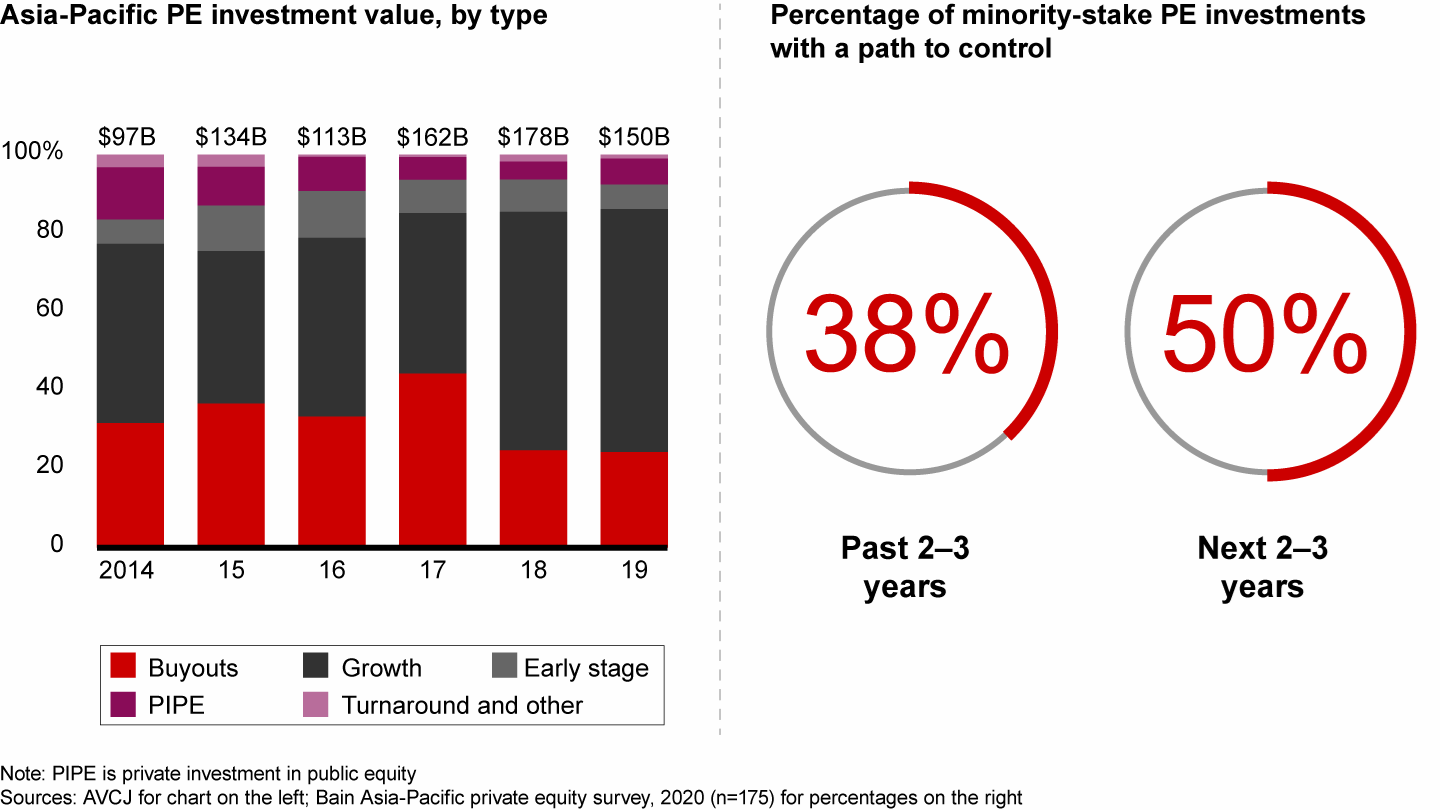
Global and domestic GPs were more active than institutional and corporate investors in the region, although domestic GPs’ share of deals fell to a five-year low. The 2019 drop in domestic GPs reflects a decline in domestic funds’ activity across all geographies, particularly China, where local funds are traditionally strong. Corporate investors retrenched, taking part in only 13% of deals, well below 2017’s high of 20% (see Figure 2.5).
The most active Asia-Pacific investors were global general partners

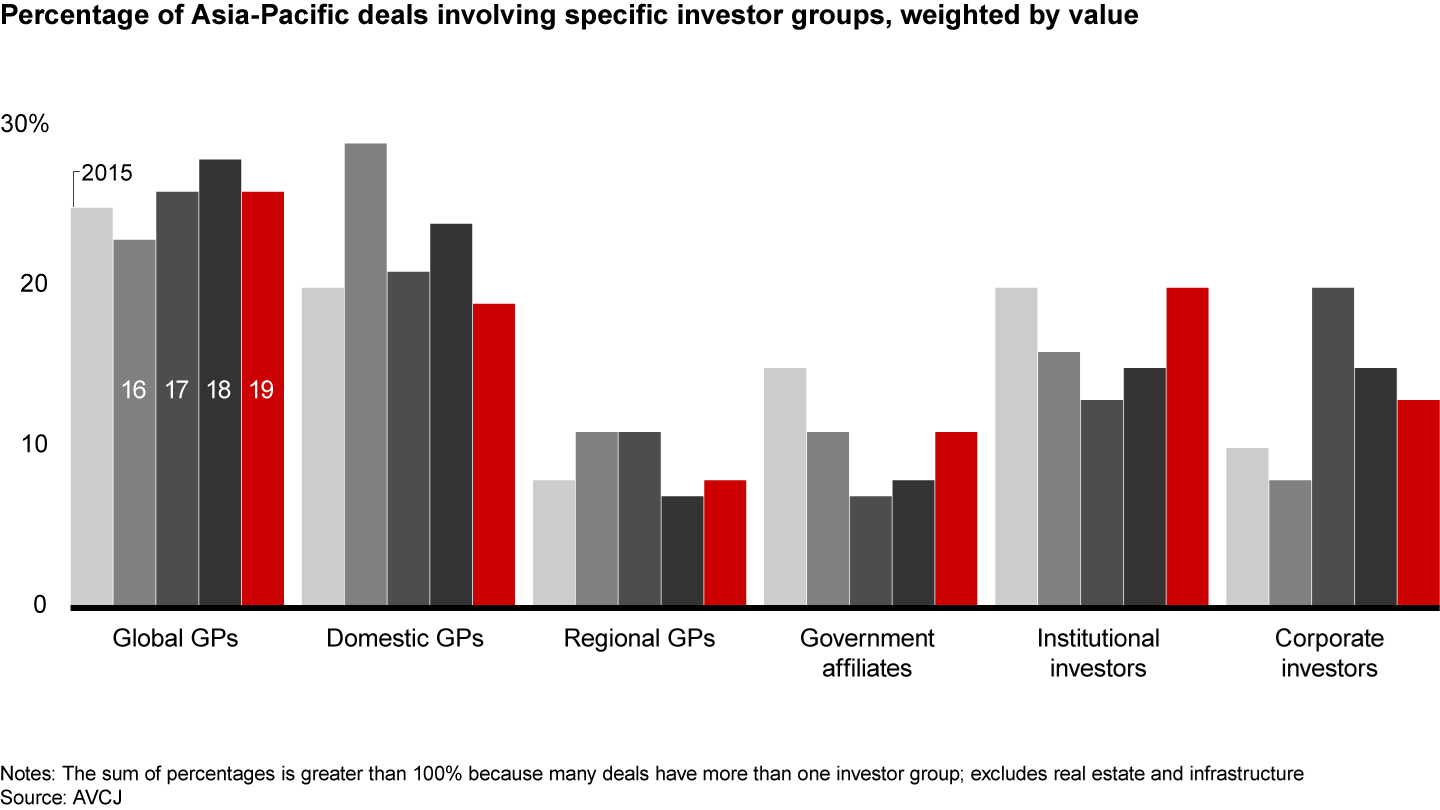
What’s clear is that a tougher investment landscape has done nothing to diminish competition in Asia-Pacific. Eighty-five percent of PE funds say that rivalry for the best deals has increased in their primary market, with other GPs considered the biggest competitive threat, followed by corporate investors and LPs investing directly. The number of active investors in 2017 to 2019 reached a record 3,300, compared with 2,700 for 2015 to 2017, though the growth has plateaued. The top 20 players were involved in 31% of deals by value, roughly on par with prior years (see Figure 2.6).
The Asia-Pacific market remains fragmented, and competition is increasing

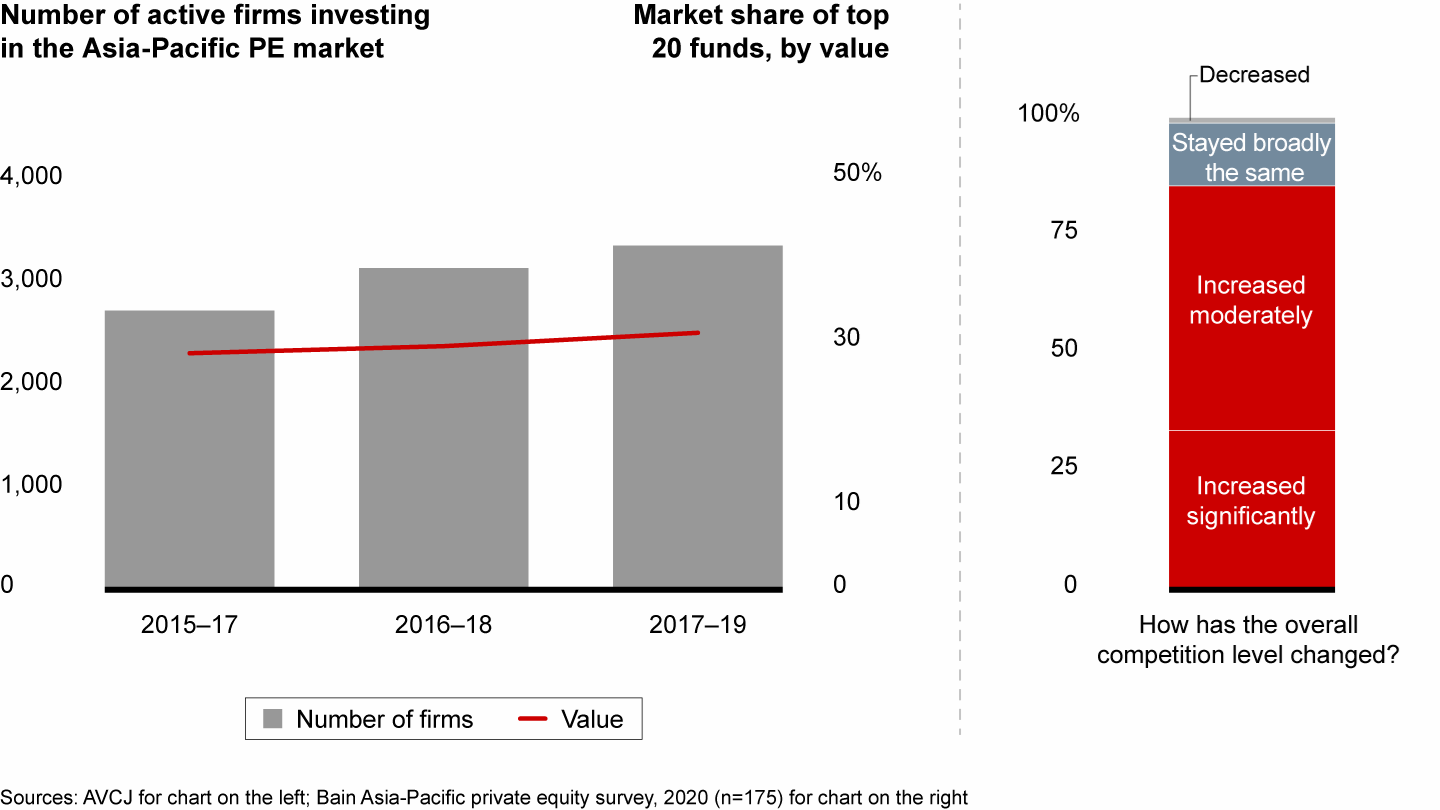
The wave of investors chasing deals of all sizes has surged, pushing valuations to exorbitant levels over the last few years. According to our survey, GPs’ No. 1 concern is high prices.
Despite intense competition, slowing GDP growth and the increasing likelihood of a global recession have given many investors pause. For the first time since 2013, multiples contracted slightly in a few regions, with median enterprise value-to-EBITDA entry multiples for PE-backed transactions declining to 12.9 from 13.3 in 2018 (see Figure 2.7). About 60% of the GPs expect valuations to decline further in the coming two years. Many of the funds we’re working with don’t include any multiple expansion in their valuation model, a change from five years ago, when 38% said multiple expansion was the biggest factor contributing to returns. Maintaining a high IRR in that environment will require GPs to find new sources of value and work harder to expand revenues and margins.
Asia-Pacific deal multiples are starting to contract

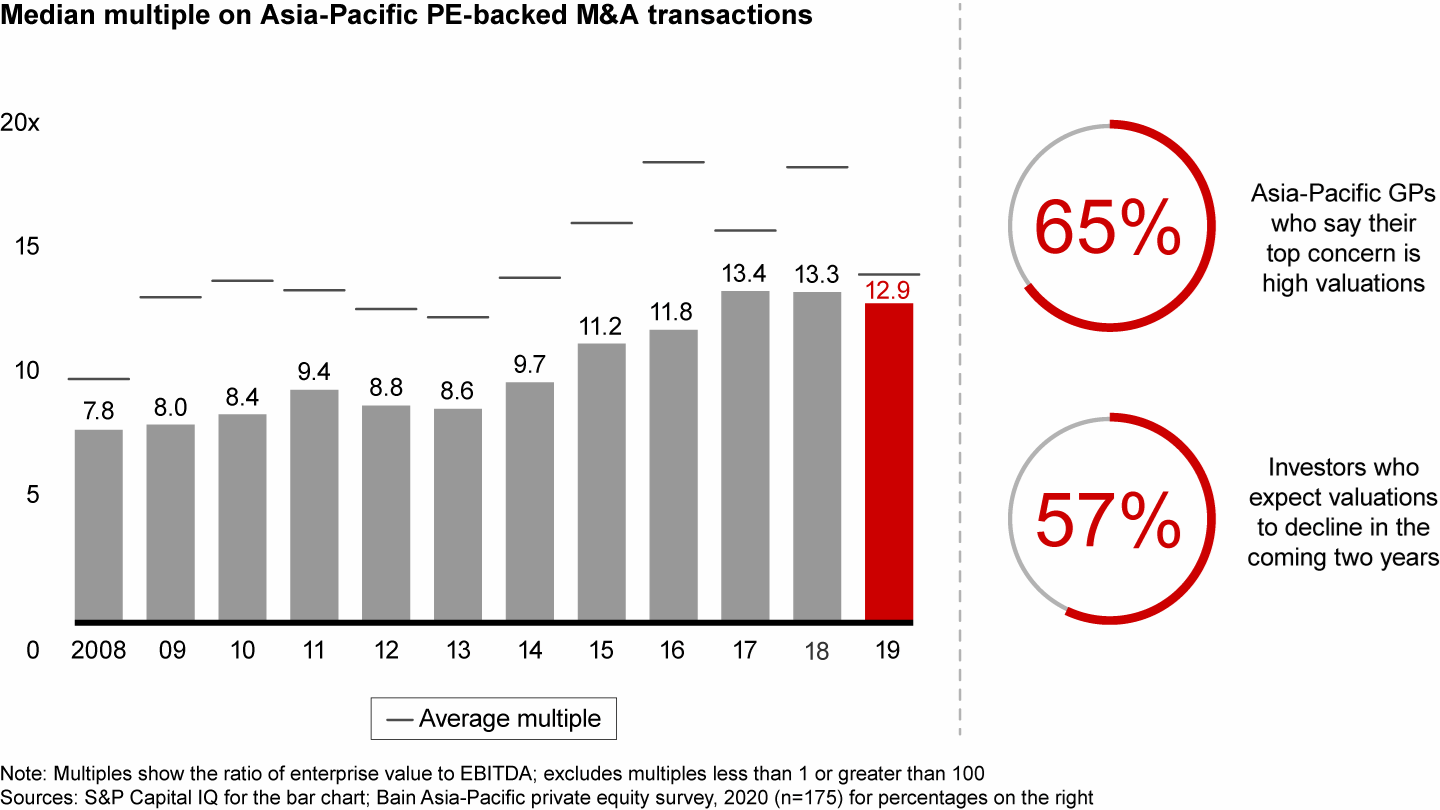
Exits: A breathtaking fall
Exits dropped even more precipitously than deal value. After setting a record in 2018, pushed by the $16 billion sale of Flipkart, Asia-Pacific’s exit market plunged, breaking the recycling of capital that fuels the next investment phase. Exit values totaled $85 billion, down 43% from 2018 and 31% from the previous five-year average (see Figure 2.8). With a bumpy stock market and timid corporate M&A activity, exits to other PE funds gained in importance: The share of secondary sales jumped to 17% from a 10% average over the previous five years.
Asia-Pacific exit value plunged by 43%, and exit count dropped to a 10-year low

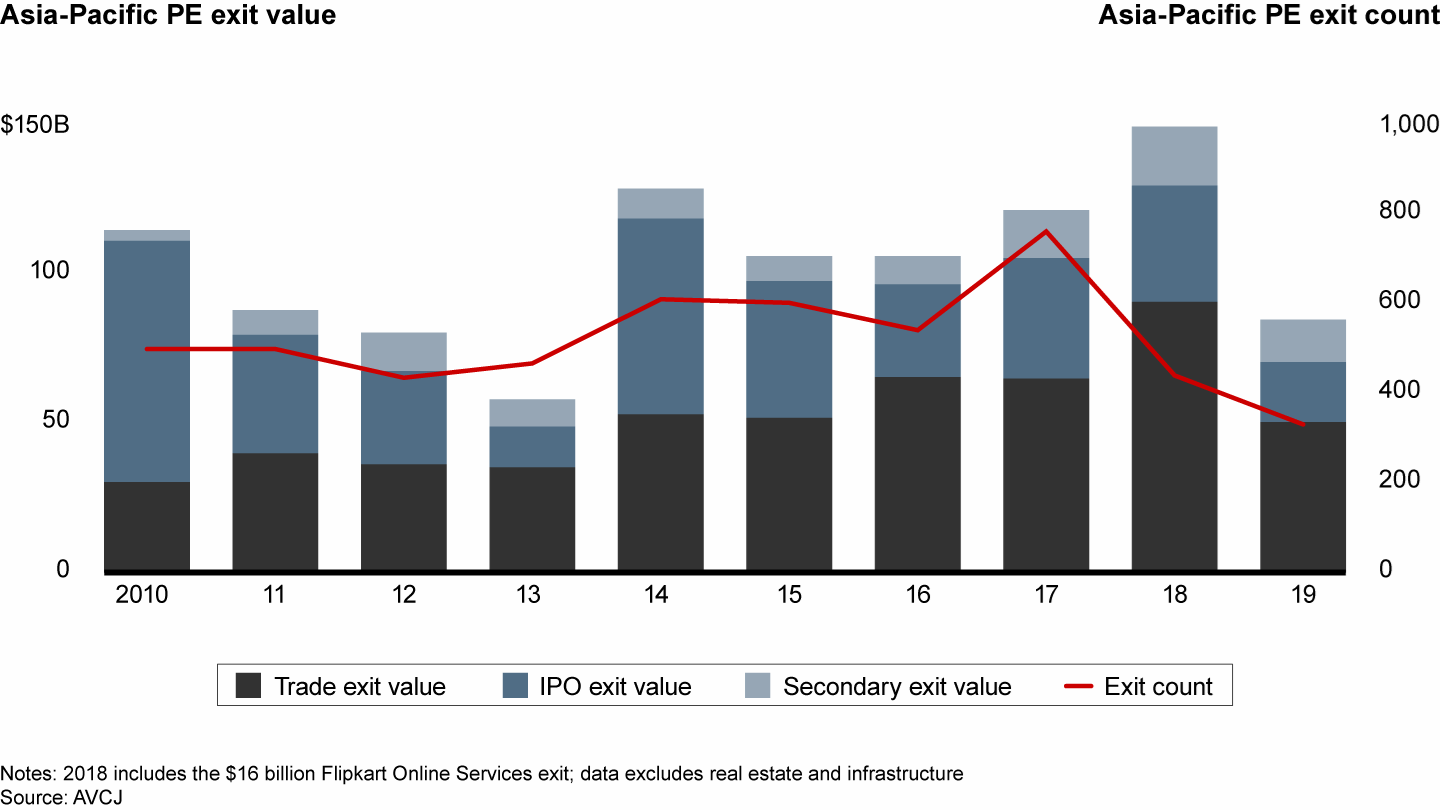
Exit value declined primarily because GPs sold fewer assets, as opposed to selling smaller companies. Exit count plummeted to 330 sales, a 10-year low, with double-digit drops everywhere. It was a striking contrast to the region’s peak year in 2017, when the total number of exits reached a record 760. GPs felt this seismic shift on the ground: Roughly half of the PE funds we surveyed said the exit environment was more challenging in 2019 than in 2018.
Several factors contributed to the broad downturn in exits, particularly a poorly performing initial public offering (IPO) market and soft macroeconomic conditions. During the booming sale markets of 2017 and 2018, GPs trimmed their portfolios. That allowed them to hold off in 2019 while working to boost value.
With exits on hold, the value of companies held in PE portfolios, or unrealized value, reached a new high of $806 billion in June 2019, up 32% from a year earlier. The good news is that strong exit activity in recent years has led to younger portfolios overall (see Figure 2.9).
Asia-Pacific GPs’ portfolios kept growing, but younger vintages made up a greater share of the total

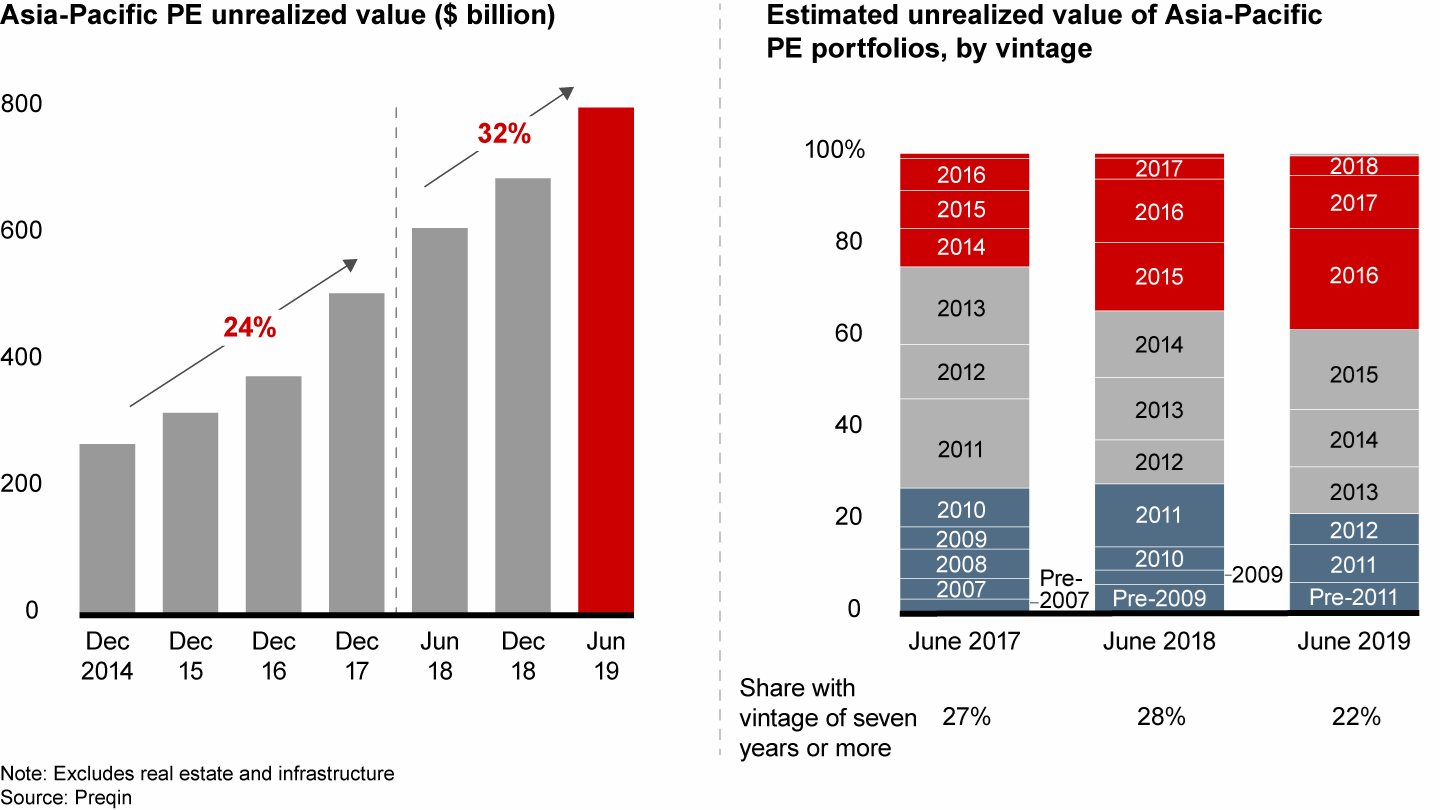
Fund-raising: Another dip
As funds returned less capital to LPs, fund-raising activity from purely Asia-focused funds fell further (after plummeting in 2018), and was 45% below the previous five-year average. The region’s share of global fund-raising dipped to 13% from 16% a year earlier. With ample stocks of dry powder, and peak sums raised in 2016 and 2017, GPs were under less pressure to raise new capital (see Figure 2.10). Conditions remained extremely soft for renminbi-based funds. The stringent asset-management rules China introduced in 2018 that prevented insurers, banks and other financial companies from investing in private equity have been partially lifted. But they still limit the ability of Chinese GPs to raise renminbi funds (see Figure 2.11).
Abundant dry powder in the region meant GPs were under less pressure to raise funds

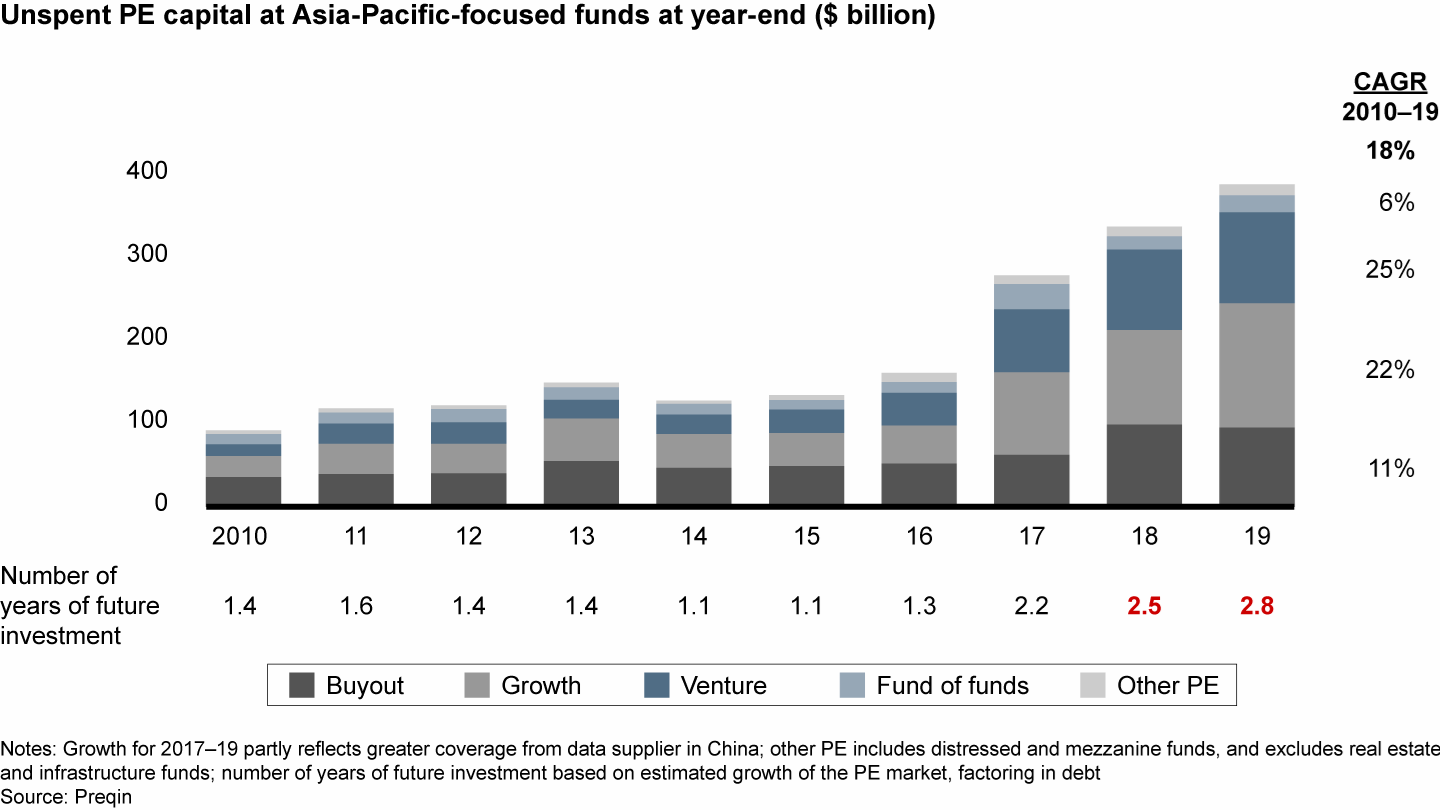
Asia-Pacific fund-raising declined as renminbi-based funds continued to plummet

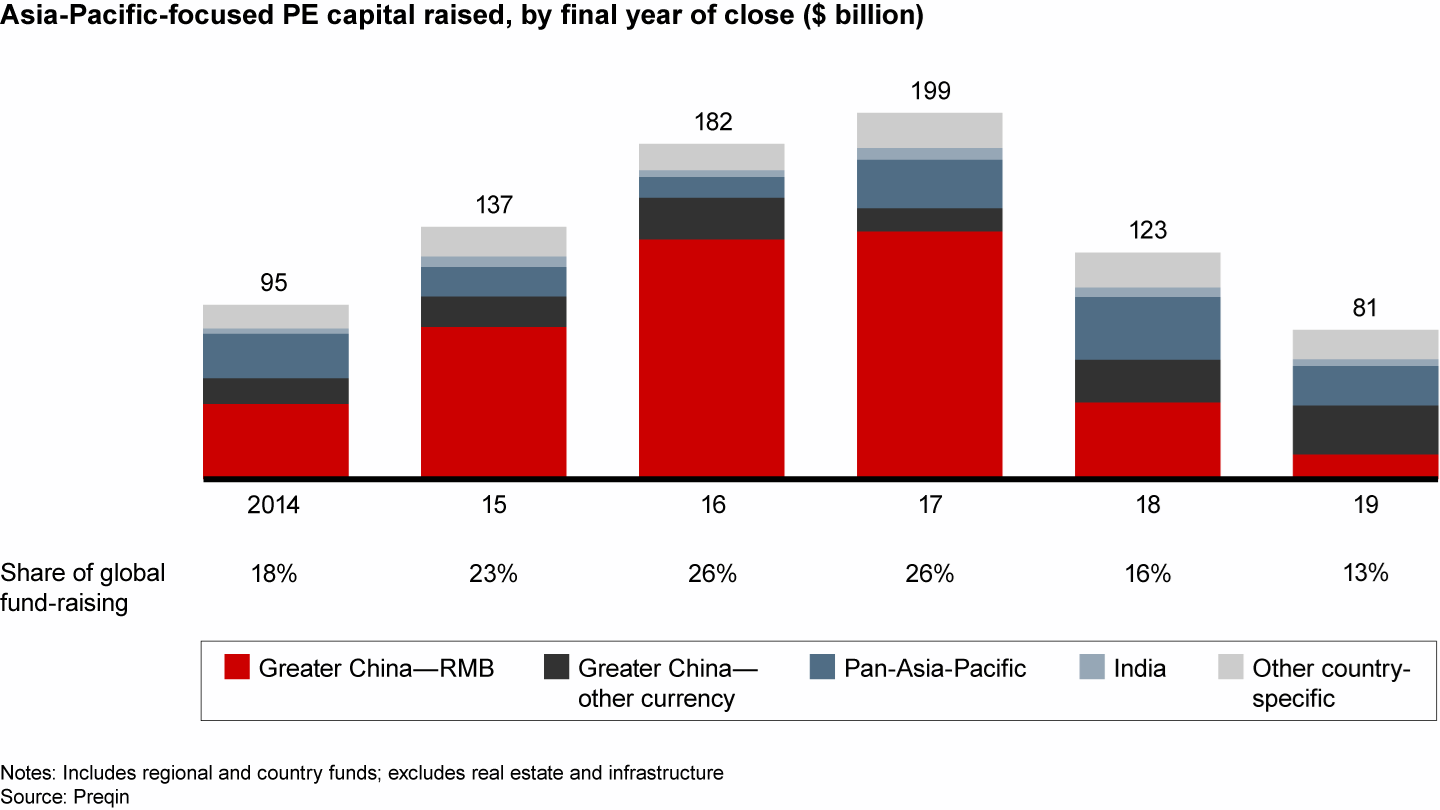
Fund-raising data underscored the ongoing flight to quality, with the average size of Asia-Pacific funds expanding to a record $282 million from $226 million in 2018. Total capital raised was spread among far fewer funds, which closed 8% ahead of their target (see Figure 2.12).
In fund-raising, winners continued to take all

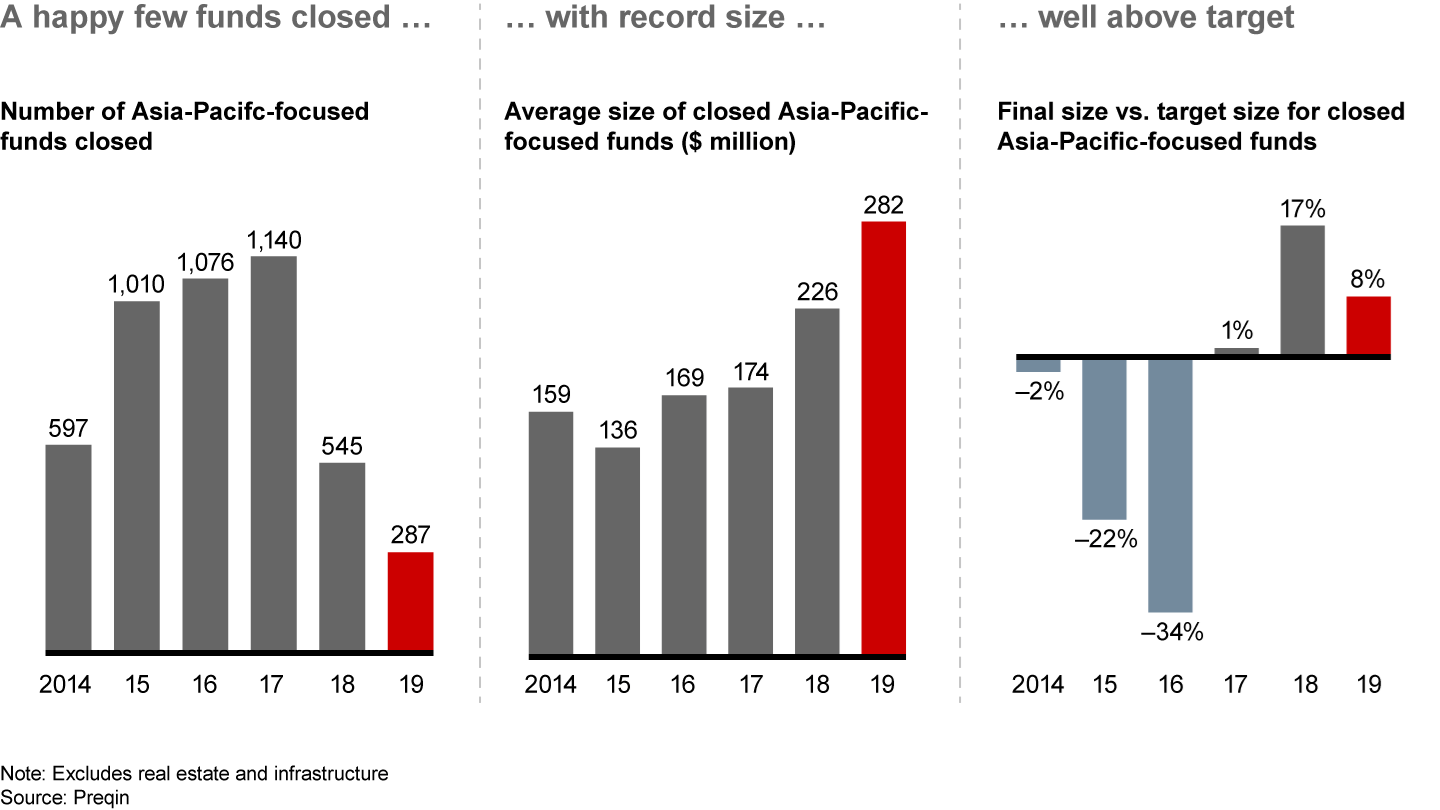
Investors continue to be highly selective about the GPs they work with. As in previous years, LPs favored large funds with strong track records. It took large, experienced funds an average of only 12 months to close, and 100% met or exceeded their targets. For instance, Permira raised its $12 billion VII buyout fund in nine months, and Warburg Pincus raised its $4.2 billion China–Southeast Asia II fund in five months, with both exceeding their targets. By contrast, smaller and newer funds had a much harder time raising capital. Smaller funds were on the road for 22 months on average, and only 60% met their targets (see Figure 2.13).
Asia-Pacific investors’ flight to quality benefits large funds with established track records

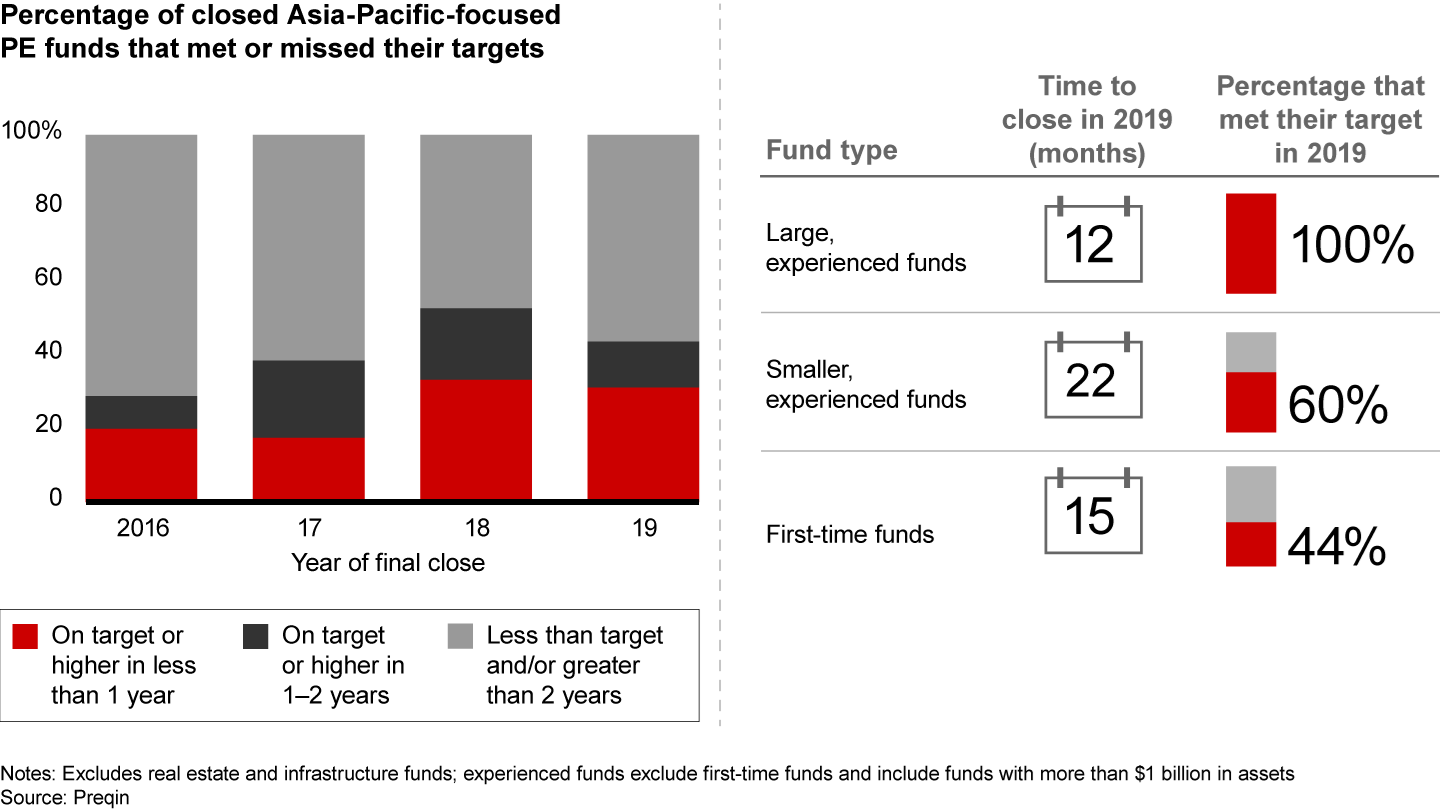
Returns: Steady for now
Despite slower market momentum, private equity continued to outperform the public market. Over 1-, 5-, 10- and 20-year horizons, the IRR for Asia-Pacific buyout and growth funds have been at least six percentage points higher than comparable market benchmarks (see Figure 2.14).
Private equity continued to outperform the stock market, but LPs’ cash flow turned negative in late 2018

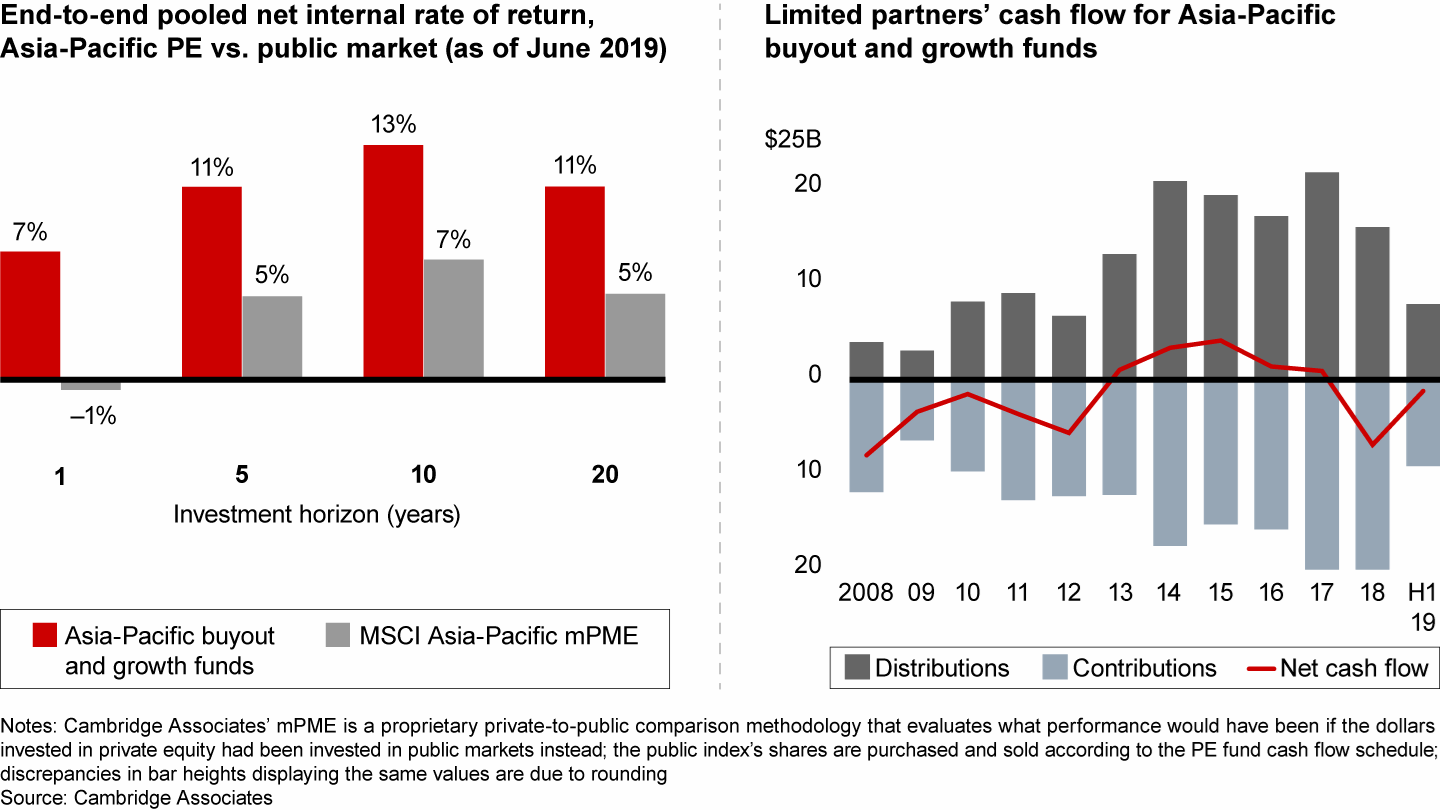
Overall, industry returns were stable at 12% median net IRR. While it’s too early to know how younger vintages will perform, top performers continued to deliver well above expectations of 16% returns for Asian emerging markets. But IRR was trending down for most recent funds (see Figure 2.15). With exits down, LPs’ cash flow in the fourth quarter of 2018 dipped into the red for the first time since 2013, and was negative again in the first half of 2019, with 86 cents returned for each $1 invested.
Asia-Pacific returns remain strong

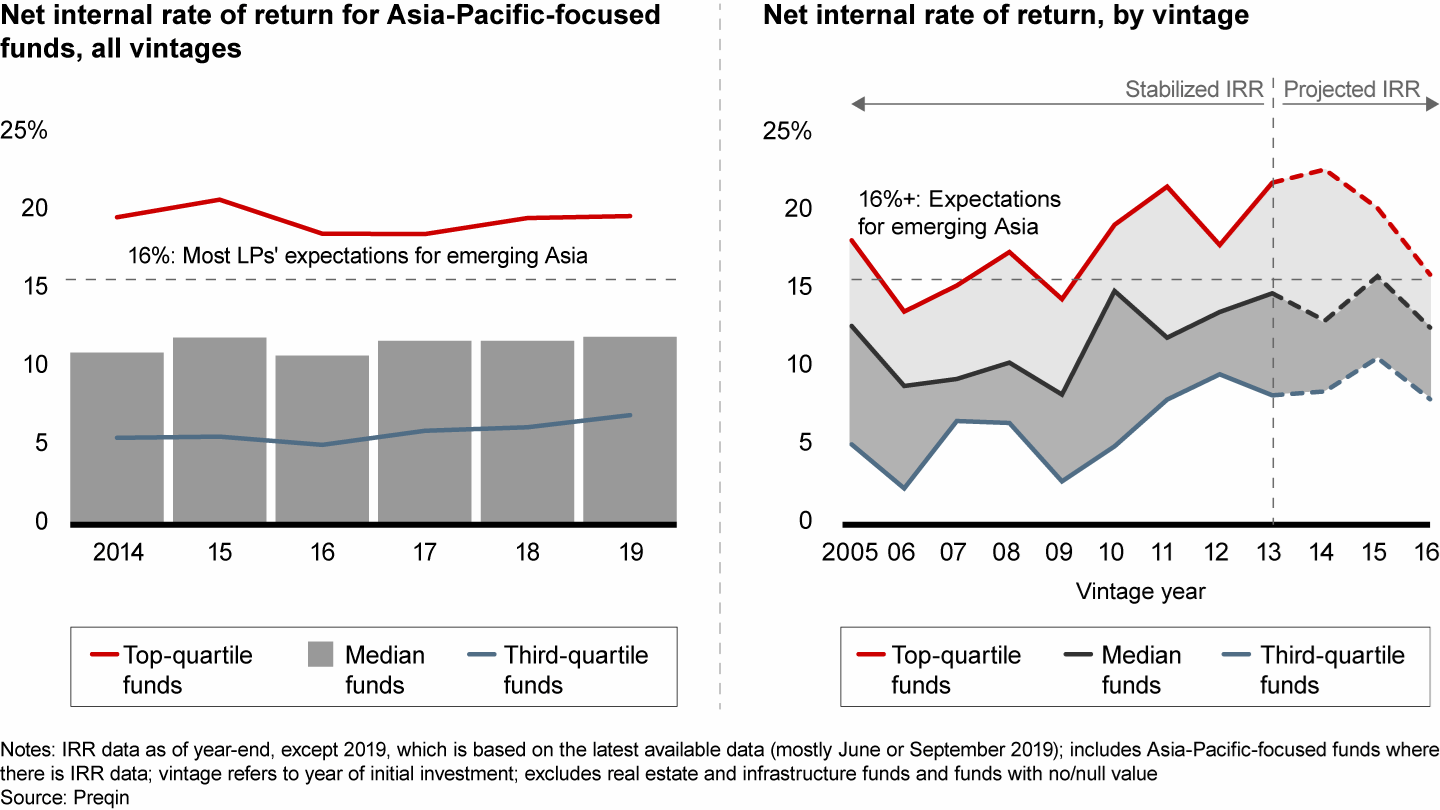
Negative returns will push PE firms to focus more intensely on value creation. While most expect top-line growth to continue fueling returns over the next five years, they’re increasingly counting on margin expansion and M&A as sources of returns (see Figure 2.16).
GPs are changing their sources for creating value

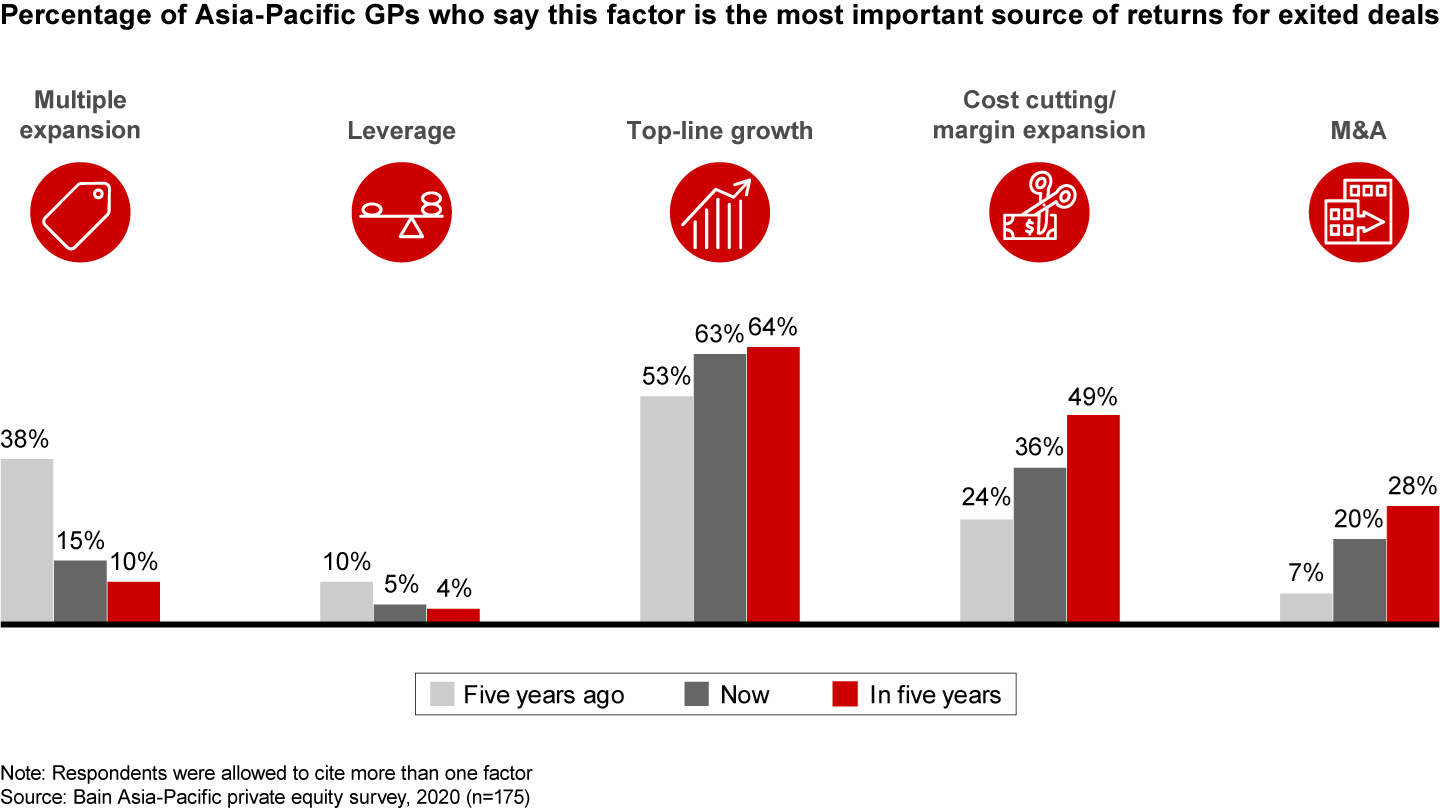
Opportunities despite uncertainty
The region’s private equity landscape is in flux. Elevated prices, increased competition and limited exit opportunities could make it tougher for GPs to replicate the returns of the past few years. An uncertain landscape has accelerated investors’ flight to high-quality assets, and that trend is likely to widen the gulf between winners and losers.
However, several positive developments and innovations on the horizon may help reignite investment activity and optimism, including the pending Regional Comprehensive Economic Partnership (RCEP). This Asia-Pacific trade bloc deal, if signed by the 15 intended countries, would create the world’s largest free trade pact, comprising nearly a third of the world’s population and about one-third of GDP. Members of the pact are counting on it to counterbalance the economic slowdown in China and stimulate economic growth, trade and investment. However, India’s opt out in late 2019 was a serious blow to the negotiations, and time will tell how valuable this deal will be to the region.
Many funds are incorporating environmental, social and governance (ESG) considerations in their investment decisions at an accelerating clip. Sixty-eight percent of investors say they’re seeking investments that have positive social or environmental impact alongside financial returns. And 87% say they plan to increase their focus on sustainability investing in the coming three to five years. As the debate about environmental and social concerns grows more acute, all private equity firms will need to consider how ESG issues affect their portfolios.
A decade has passed since the end of the global financial crisis. With the risk of a global recession looming, it’s a good time to ponder the lessons learned from the last one. During economic downturns, the gap between winners and losers widens, and turbulent times pave the way for smart funds to leapfrog the competition. Successful investors are preparing for a more difficult road ahead, putting in place strategies to mitigate volatility. They are taking a more active role and pursuing new approaches to deal sourcing, deal assessment and portfolio management.
It’s also a good time for GPs to rethink their investment strategy for Internet and technology companies. This fast-evolving sector offers attractive new investments in second-generation technologies. But the risks associated with high prices and a stampede of investors chasing deals are as high as ever. Leading funds are building specialist teams and new capabilities to make the most of new opportunities.

3. Looking forward—key trends in 2020 and beyond
Downturn and disruption
Turbulence ahead
After a long and robust period of growth, many indicators now point to downturn and disruption. Smart investors are bracing for what could be a perfect storm. Fundamental changes to the macro landscape, changing demographics and rising inequality are likely to trigger serious economic and social imbalances in the coming decade. For governments, companies and investors, it will be a time of unprecedented challenges.
The most immediate concern is a global downturn that brings an end to the long-running expansion. Economists forecast China’s coronavirus outbreak will slow the country’s growth, heightening the risk of a global economic downturn. But other factors cloud the horizon too. The US-China trade dispute and Brexit create critical challenges for supply chains and increase investor uncertainty. The International Monetary Fund (IMF) warns that conditions are ripe for the next global financial crisis, and banks are poorly prepared for it. Some economists forecast oil supplies may run short in the coming decade as demand for energy continues to grow in the wake of a slowdown in capital investment. The geopolitical crisis in Iran or conflict elsewhere in the Middle East also could precipitate a squeeze on oil supplies.
Add to that troubling outlook the unpredictable effects of climate change. And as the world’s population swells toward an estimated 10 billion by 2050, its consumption of natural resources is accelerating. Extreme inequality, which has triggered violent social unrest around the world, is on the rise. Ongoing civil protests, including those in Hong Kong, add to an increasingly unstable political climate.
Perfect storm or not, the effects of these trends are sobering. The IMF estimates that in 2019, global growth in 90% of the world slowed to its lowest rate since 2010. It also forecasts that the trade war between China and the US could cost an increasingly fractured global economy $700 billion in 2020. It’s impossible to evaluate the potential cost of damage from events related to climate change in the coming years, but new data triples previous assessments of infrastructure, businesses and individuals vulnerable to rising sea levels by midcentury. Even if governments agree to battle climate change by scaling back carbon emissions, that effort risks creating stranded assets in fossil fuels, energy infrastructure, transport and other industries.
Those somber forecasts have investors on edge. Fifty-nine percent of Asia-Pacific GPs ranked macroeconomic conditions—mainly associated with the financial crisis and trade war—among the top three issues keeping them awake at night. Almost half said they believe private equity has now passed its peak or entered a recession phase, and a striking 96% expect a downturn in the next two years, with 54% anticipating a severe or moderate impact on their portfolio (see Figure 3.1).
Asia-Pacific fund managers feel increasingly anxious

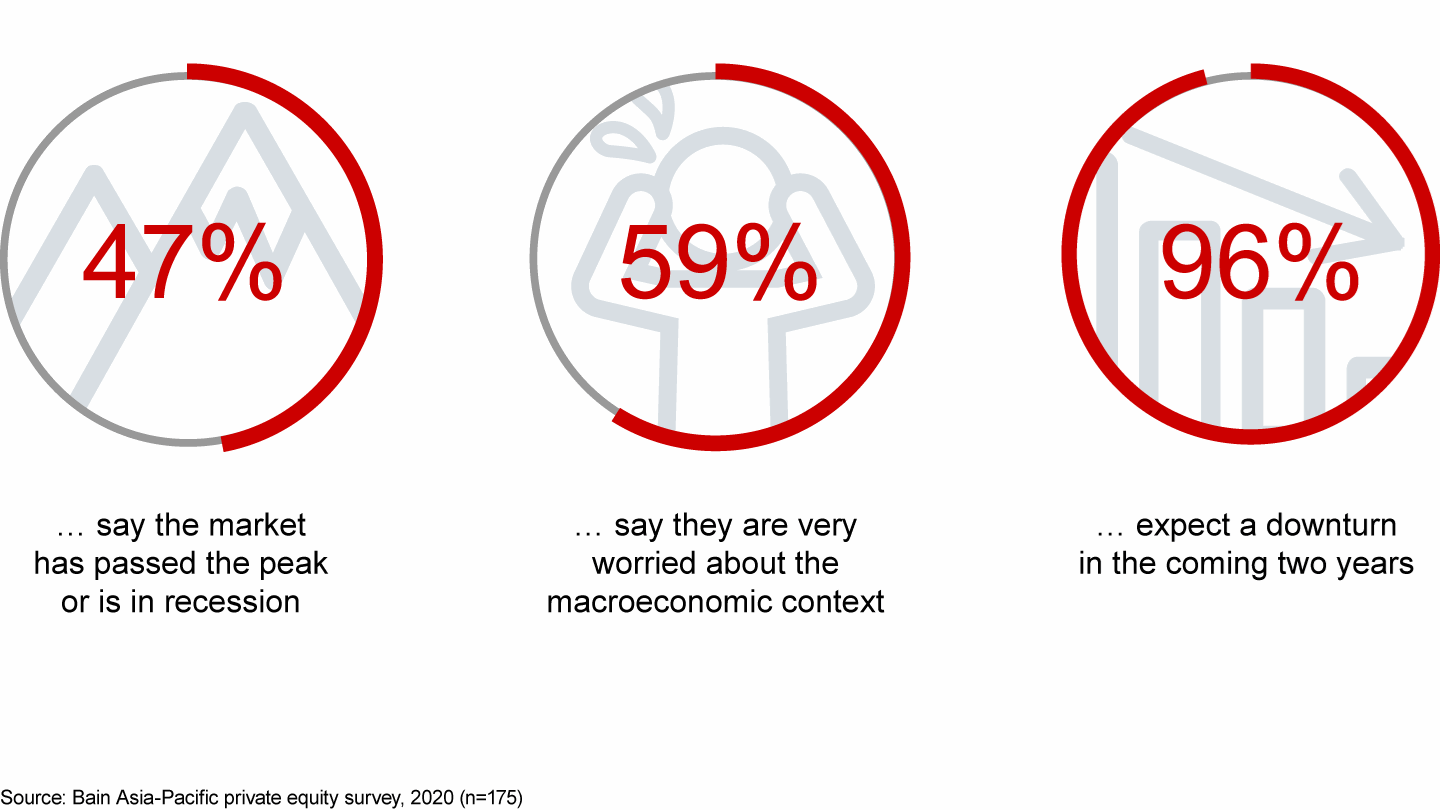
In addition to the macroeconomic challenges, record-high multiples risk making it harder for funds to sustain returns if they start to decline. Since 2016, more than 40% of Asia-Pacific PE-backed deals had an entry multiple higher than 15, compared with 25% to 30% from 2010 to 2015 (see Figure 3.2).
About 40% of private equity deals are currently trading at multiples above 15

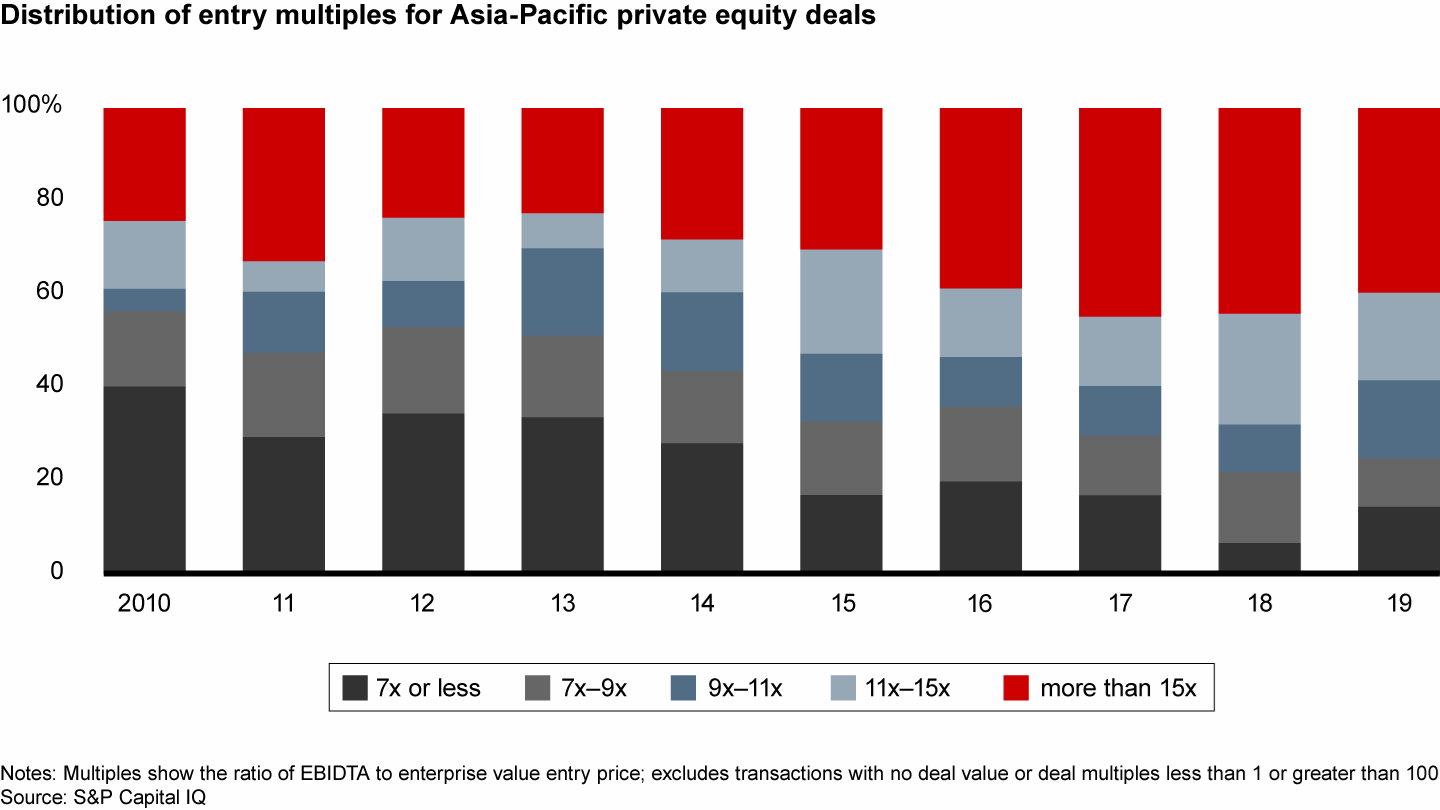
Lessons from the global financial crisis
In hard times, the performance gap between winners and losers widens significantly. One reason: Leading PE companies have learned how to embrace uncertainty and turn it to their advantage. The losers, by contrast, fail to anticipate change and are buffeted by market developments.
Let’s take a closer look at the performance of Asia-Pacific PE funds during and after the global financial crisis of 2008–2009. From 2008 to 2014, more than a quarter of the Asia-Pacific PE funds that had raised $500 million or more closed. A quarter raised 20% less in those seven years, compared with 2001 to 2007—we define them as “failures.” The winners, one-third of the group, catapulted ahead, raising 20% more capital from 2008 to 2014 (see Figure 3.3).
The performance of Asia-Pacific-focused PE firms diverged sharply during and after the 2007–09 recession

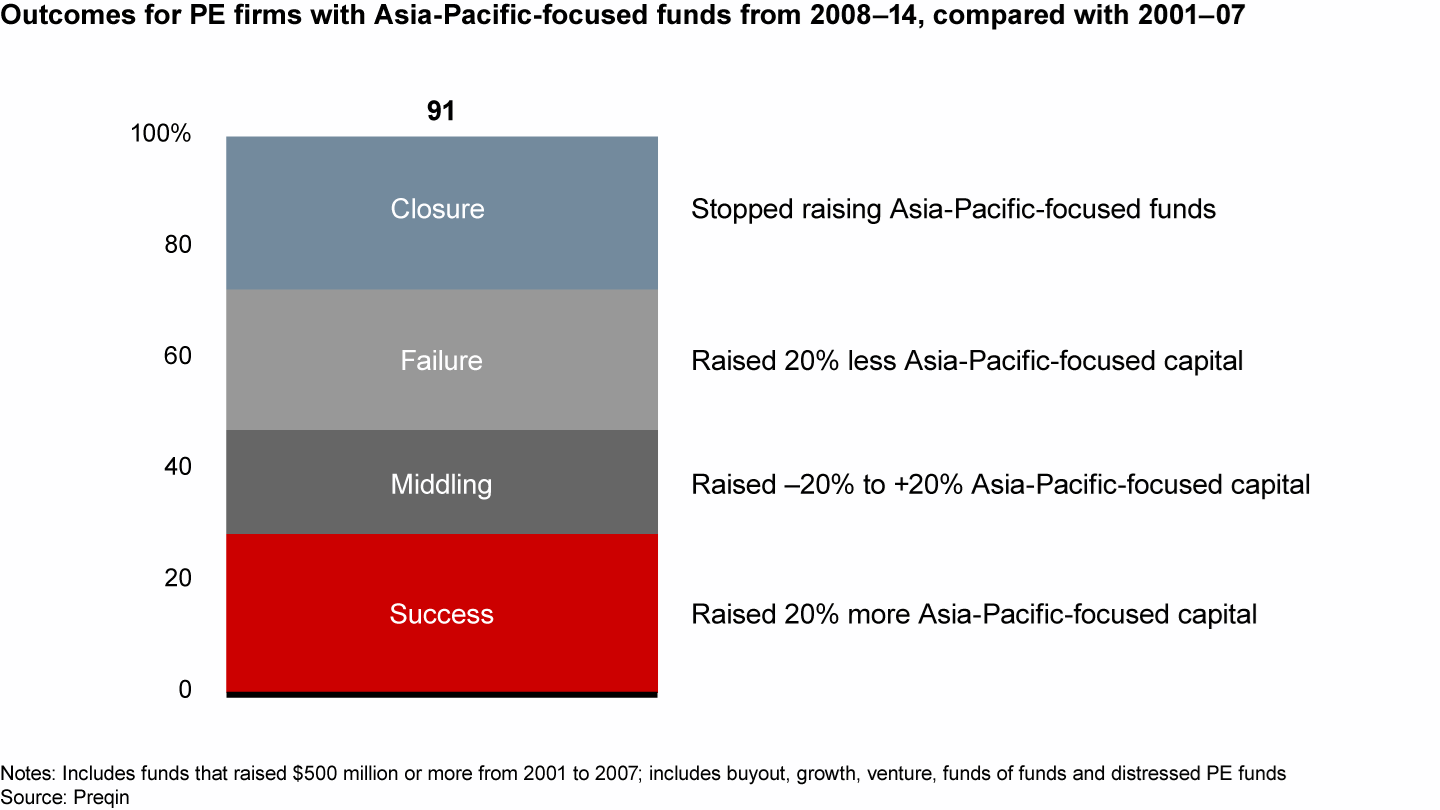
What sets the winners apart from the rest? To answer that question, we analyzed around 2,500 Asia-Pacific deals and 1,280 exits from 2001 to 2007 that were greater than $10 million, excluding real estate and infrastructure. Our analysis of fund performance revealed several vital insights about how investors can survive and thrive in a downturn. Specifically, successful funds understand four important truths about the market:
- Greater control over deals and active portfolio management improves returns. PE funds that outperformed during and after the financial crisis did a larger proportion of buyouts. As a result, they had a greater ability to control deals and influence value creation. Sixty-six percent of all deals done by successful funds were buyouts, compared with 36% for funds that failed (see Figure 3.4). Generally, funds in the first quartile intervene more frequently to help portfolio companies create value and remain engaged in that process throughout ownership.
Control over deals and active portfolio management are especially critical during a crisis

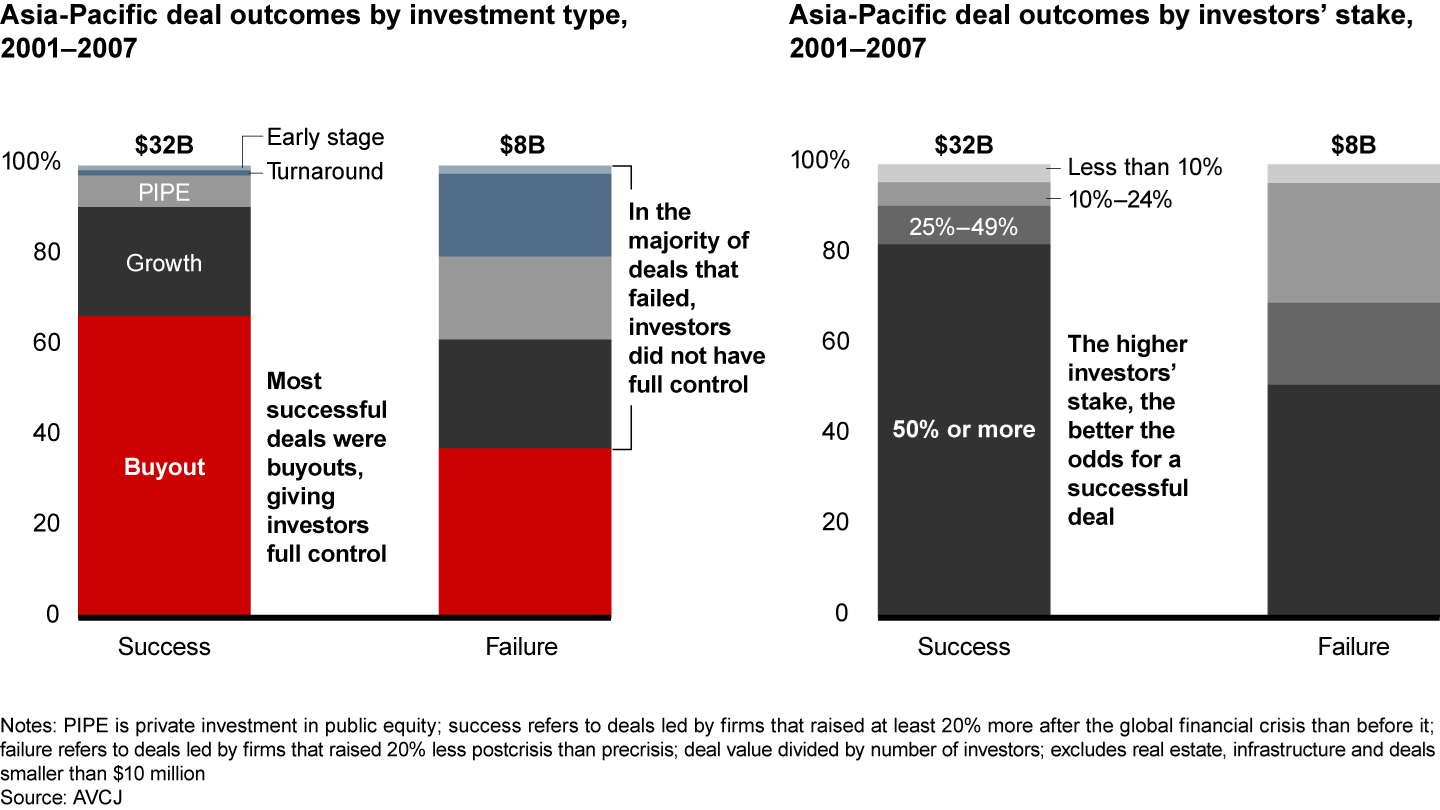
- Size matters for deals, but not for funds. Surprisingly, size didn’t create an advantage for funds struggling through the last financial crisis. Funds that raised more than $500 million prior to the crisis and failed were roughly the same size as those that succeeded. What did make a difference was the ability to coinvest without diluting power. Successful PE funds did more deals with coinvestors, and the deals were larger: 73% involved deals above $500 million. By contrast, firms that failed did only 23% of deals of that size. The average investment by successful funds was $102 million, compared with $37 million for those that failed (see Figure 3.5).
In a crisis, size matters for PE deals but not for funds

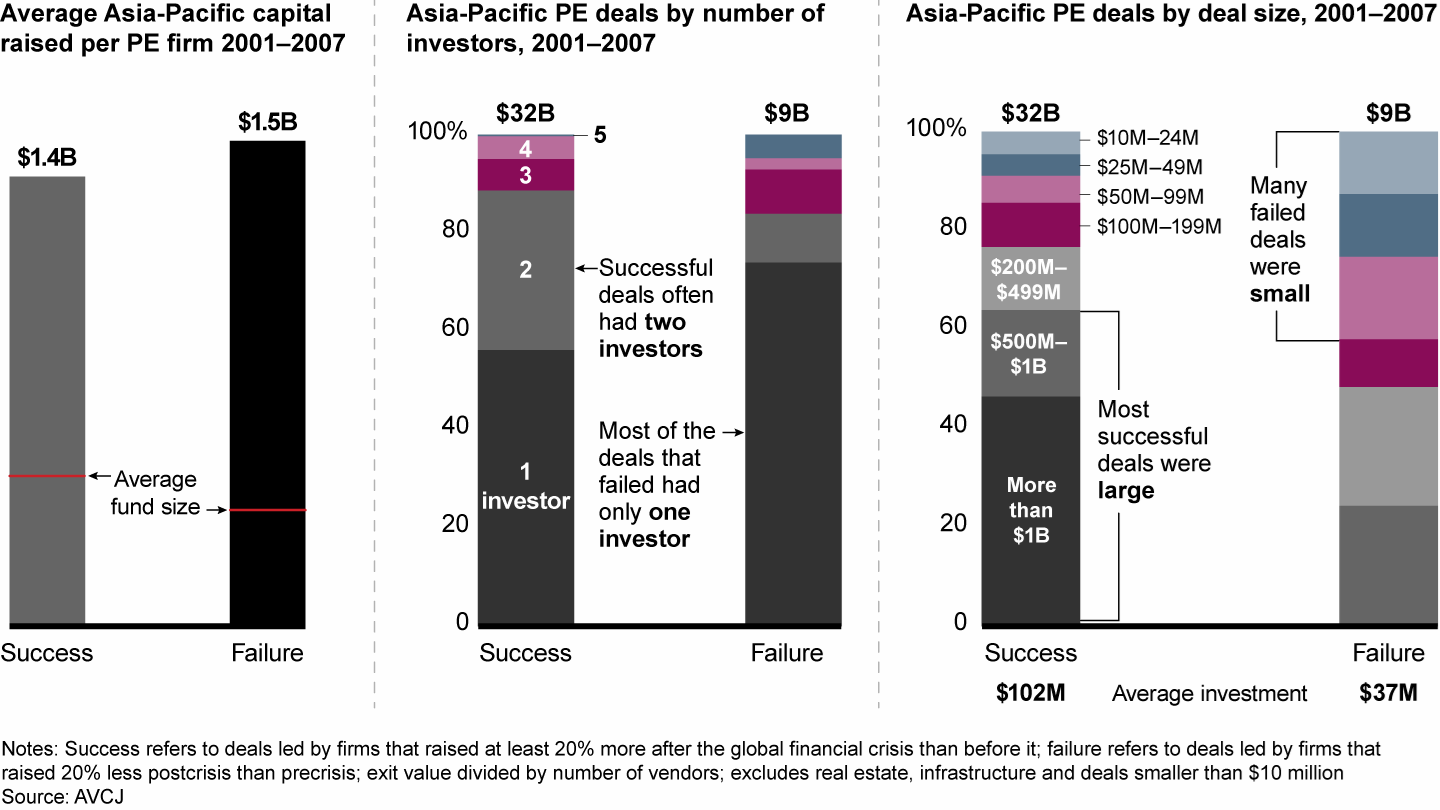
- The ability to pick winning companies is more important than choosing sectors. Some funds clearly benefit from a focused strategy in the right sector. Technology and healthcare, for example, outperformed during the past downturn. But every sector includes a large range of returns. As obvious as it sounds, the most effective approach is to target the right company regardless of sector. Our analysis of Asia-Pacific deals shows limited differences in fund performance based on sector strategy (see Figure 3.6). However, winning firms were able to consistently pick better companies.
To outperform in a downturn, picking winners is more important than choosing sectors

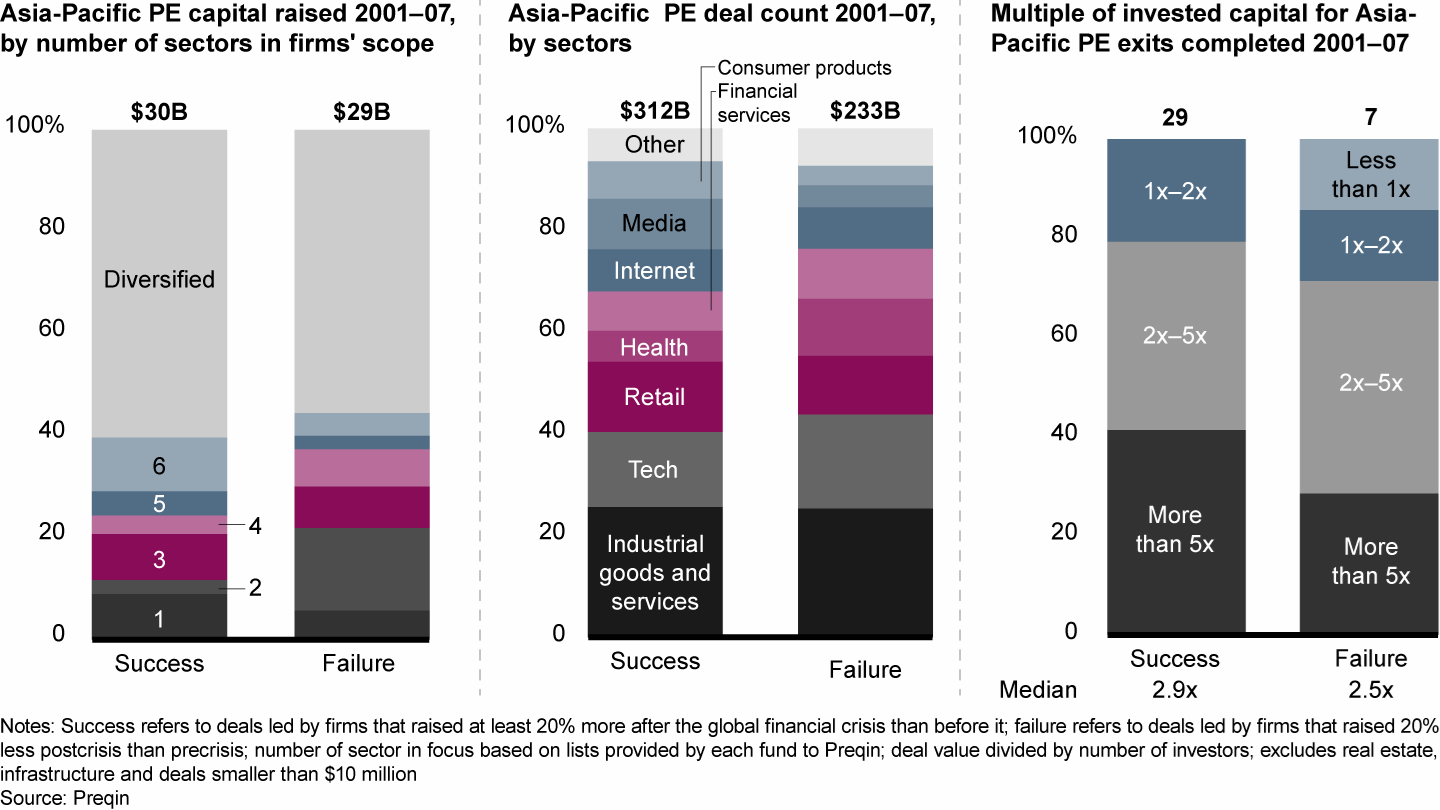
- Timing is everything. Investors have many options for improving overall fund performance, but often fail to pursue them. One is holding onto assets instead of writing them off in a weak market. Our research on deals before the financial crisis revealed a number of investments that were performing poorly in the crisis, but eventually turned around and delivered strong returns after markets recovered. Successful funds avoided exits during the financial crisis. They sold less than 10% of estimated assets under management on average during 2008 and 2009, compared with almost 20% for firms that failed (see Figure 3.7).
Successful PE firms made relatively few investments or exits during the financial crisis

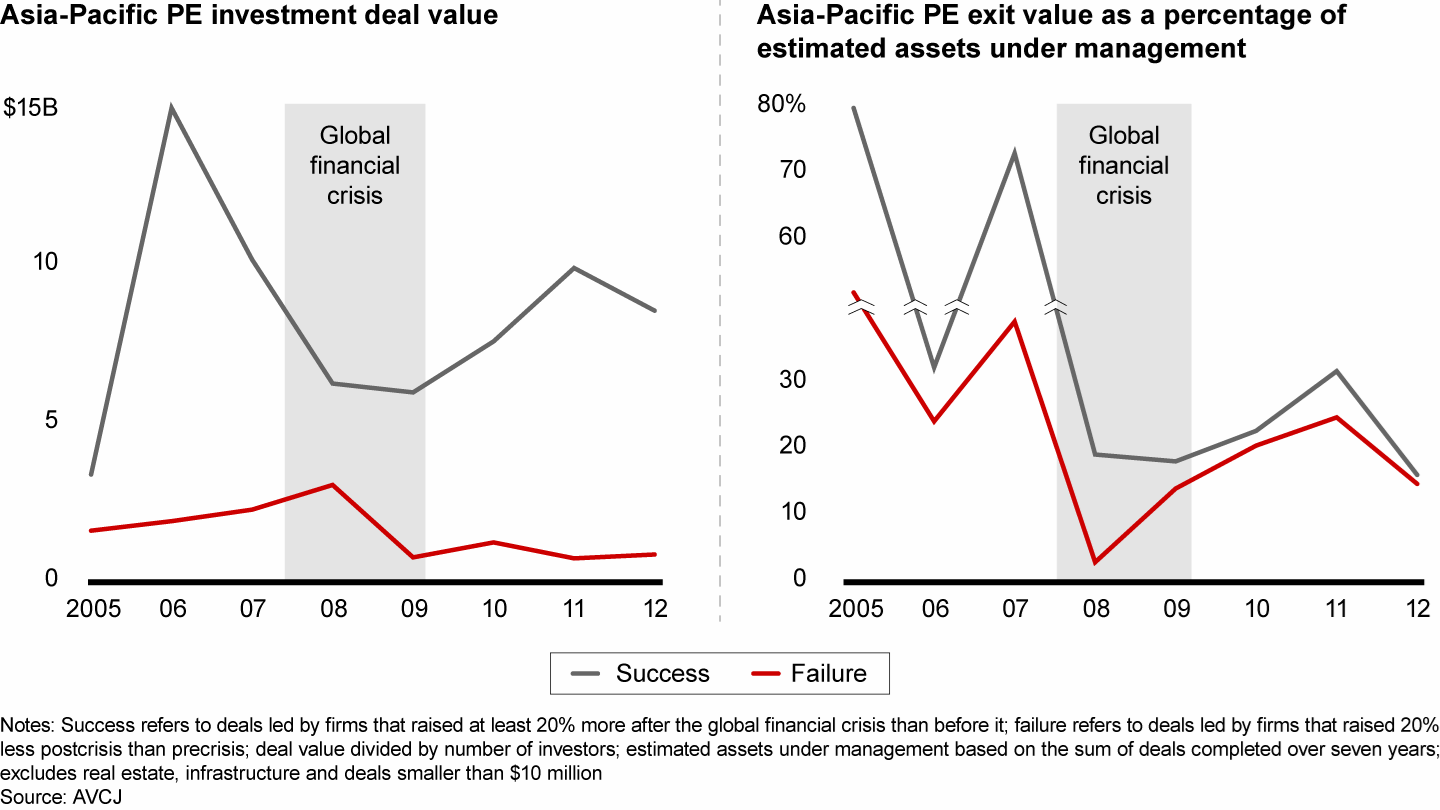
Another key insight on managing timing: Successful firms did few deals during the financial crisis but started to invest again in 2009. Firms that failed continued investing during the crisis.
How does the investing landscape look in 2020? Nearly 80% of GPs in Asia-Pacific told us they’ve started to alter their investment strategy to brace for recession. Concrete changes include assessing disruption and recession risks more systematically during due diligence (81%) and putting more emphasis on profitability and cost reduction for portfolio companies (58%). GPs also are accelerating exits for some companies (44%). Overall, funds now include a disruption- or recession-risk analysis in 57% of due diligence efforts, compared with 29% five years ago (see Figure 3.8). But even with the experience of the past downturn, only 5% of Asia-Pacific PE firms believe their portfolios are fully prepared for the next storm.
Asia-Pacific GPs are preparing for the next downturn

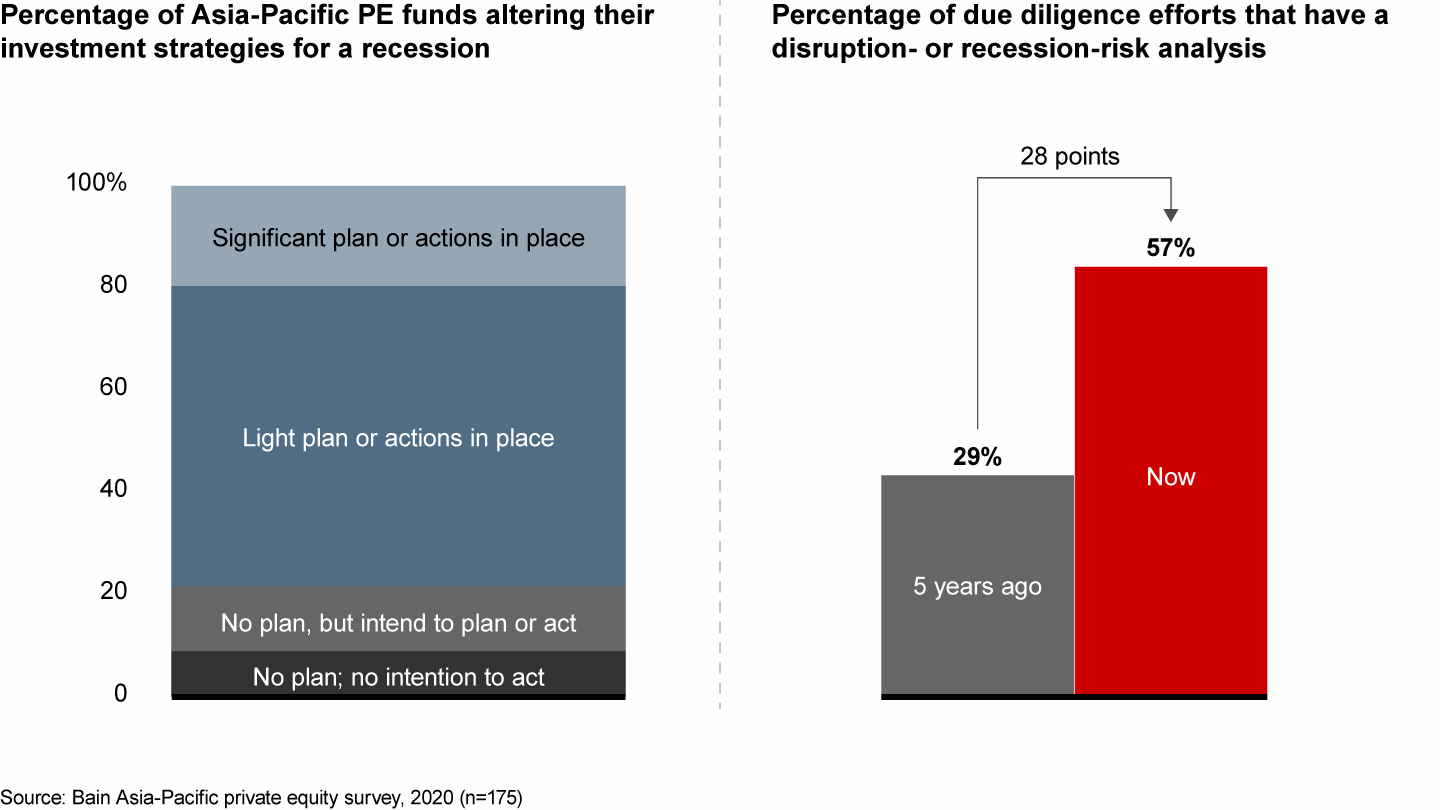
Navigating the complex currents of global trade
In addition to the risk of a global recession, many GPs are worried about the steady escalation of trade conflicts. Since early 2018, the US-China trade war has shaken long-held assumptions about doing business in a global market. For decades, governments and international organizations toiled to steadily reduce trade barriers. That effort encouraged companies to expand their supply chain networks across the globe. Despite the recent easing of US-China trade relations and the pending US-Mexico-Canada agreement, regional and global trade frictions have created a much more complex and uncertain business environment.
For private equity investors used to growing their portfolio companies in a global market, the shift is profound. Ongoing flux is the new normal. With populist movements and social unrest on the rise, governments are more likely in the future to throw protectionist fences around their markets. Coping with this increased complexity and uncertainty will make it harder for GPs to navigate profitably.
Successful private equity funds are making both strategic and tactical adjustments to reduce risks and increase their opportunities in an uncertain business environment. First, GPs take precautionary moves before buying companies in sectors vulnerable to increased tariffs. During due diligence, for example, leading fund managers anticipate how high trade barriers may rise under given scenarios, the percentage of revenue and profit that could be affected by new tariffs, and what it would mean to shift production out of trade-war zones. In short, trade-war scenario planning helps PE funds respond to vital questions:
- What share of the target company’s revenue and profit will be affected by a trade war? (This requires looking at company-level data, not just overall industry impact.)
- How much alternative capacity is there in the US or other locations to replace the current China supply? And are competitors investing to expand production capacity?
- Which locations offer the expertise and ability to respond to demand in the near term?
- What alternative plant locations would reduce the trade-war risk?
At the same time, PE firms are helping the portfolio companies grappling with higher tariffs to change their manufacturing footprint. Some already have sites outside China. Others are accelerating plans to build or acquire facilities in other overseas markets. But many funds prefer to wait for the next US presidential election before investing in additional capacity, limiting for now the impact of the trade war.
How to create a stormproof portfolio
Faced with a growing risk of trade disruption and global recession, fund managers need to learn how to outperform in a constantly shifting landscape. Successful GPs stormproof their portfolios. Our research shows these leaders manage to accelerate growth even in a shrinking economy. To better understand the funds that delivered solid gains through the 2008–2009 recession, we analyzed 2,519 Asia-Pacific companies, both private and public, and split them into two groups. The sustained value creators were those that increased revenue and EBIT at double the rate of their country’s GDP growth (after inflation) from 2007 to 2017. The others made up the second group (see Figure 3.9).
Most Asia-Pacific companies suffered in the last downturn, but some accelerated growth and profits

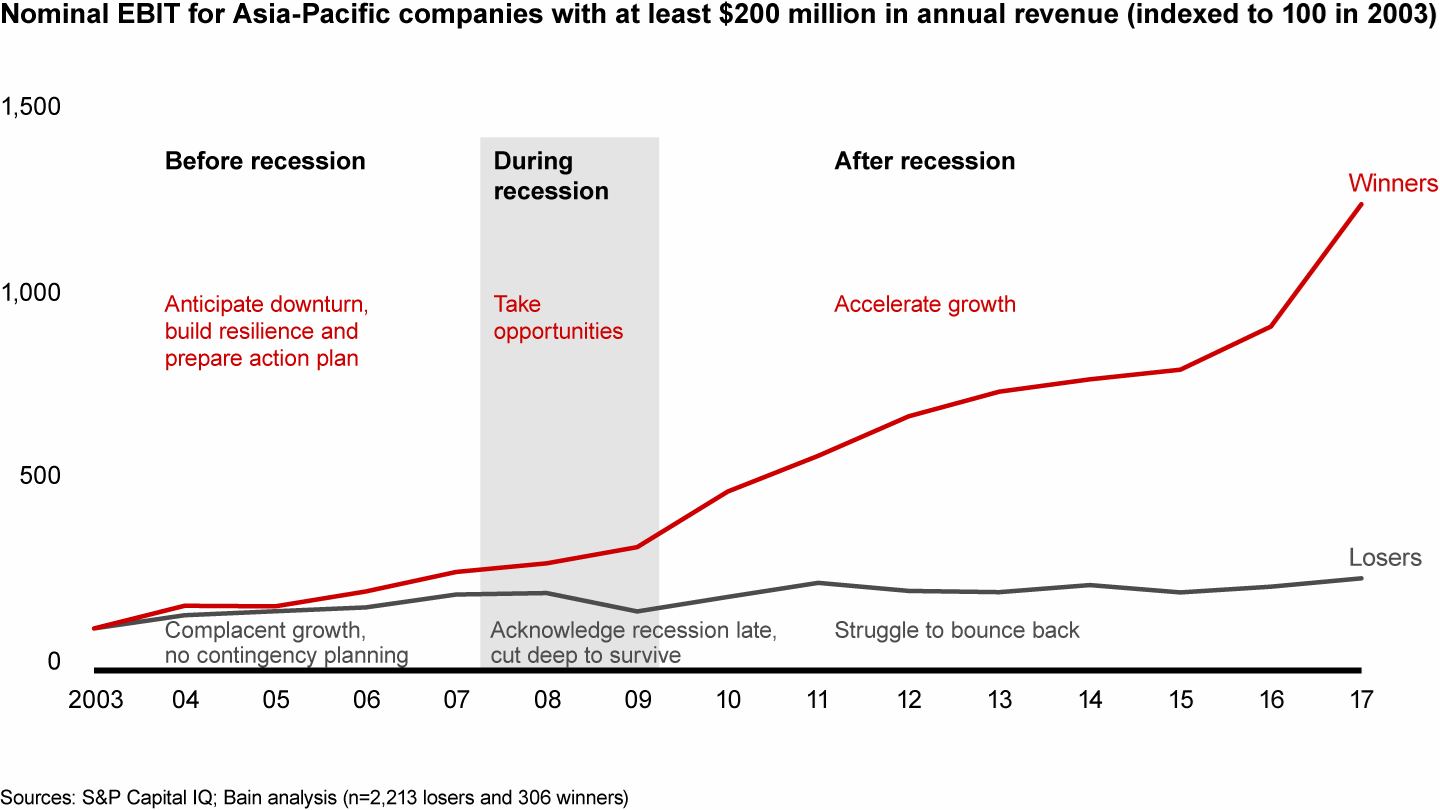
In uncertain times, winning companies change strategy. They also change the process of making strategy. The most effective leadership teams focus on a few vital uncertainties, consider the possible scenarios and identify trigger points that signal a swing to one scenario or another. That approach balances commitment with flexibility.
In our experience, companies that mobilize quickly and effectively during difficult times aren’t somehow better at predicting the future. It just seems that way, because the leadership has prepared the company for a range of future scenarios in advance.
Sustained value creators share three common traits. First, they stare hard at the risks ahead and prepare their companies early for a rough ride. Rather than adopting a wait-and-see approach to planning and investment, management commits to taking specific actions under different circumstances. If the world is evolving toward scenario X, the company has plans to roll out strategy Y. Leaders reinforce the core business so it’s resilient through the downturn. They anticipate how customer behavior could change in a recession, harness digital technologies to continue innovating and analyze whether to shift to local supply chain sourcing. At the same time, they develop growth engines for the future. In some markets, that may mean exploring more sustainable products, for example.
Value creators also help management teams adopt a founder’s mentality and build a culture riveted on the customer. That helps them maneuver adroitly when macroeconomic conditions shift.
Finally, winning companies lay a strong foundation for growth by creating a lean cost base, preparing for strategic mergers and acquisitions, and bolstering their talent base.
Our analysis also shows losers make three common mistakes. They cut costs too deeply, assuming that it’s critical to thriving in a recession. In fact, taking a blunt knife to the organization stifles growth. Typically, they rule out investment or acquisitions, slash R&D, scale back sales and marketing activities vital to commercial growth, and fire valuable talent. Losers also get distracted and forget to focus on the company’s core business. In a desperate bid for growth, they bet on new or faddish businesses. Finally, unsuccessful funds wait too long to act. Lacking an offensive strategy, they miss the opportunity to leapfrog competitors and try to ride out the storm in a defensive position.
A stormproof strategy will differ from company to company depending on its industry, strategy and financial position. The right set of moves depends on the company’s point of departure and its industry’s sensitivity to recession (see Figure 3.10). Companies in a strong strategic position and a weak financial position in industries less sensitive to downturn, such as food and beverages or healthcare, should play offense in a recession, doubling down on performance improvement, increasing revenue and improving the loyalty of their core customers. By contrast, companies in a weak strategic position, with a weak financial base in industries highly sensitive to a downturn, such as entertainment and car dealers, should “go big or go home,” either selling the business or divesting noncore assets. Going big entails bold cost-transformation moves such as investing in digitalization and pursuing game-changing mergers and acquisitions.
Start preparing for recession by reviewing your strategic and financial strength

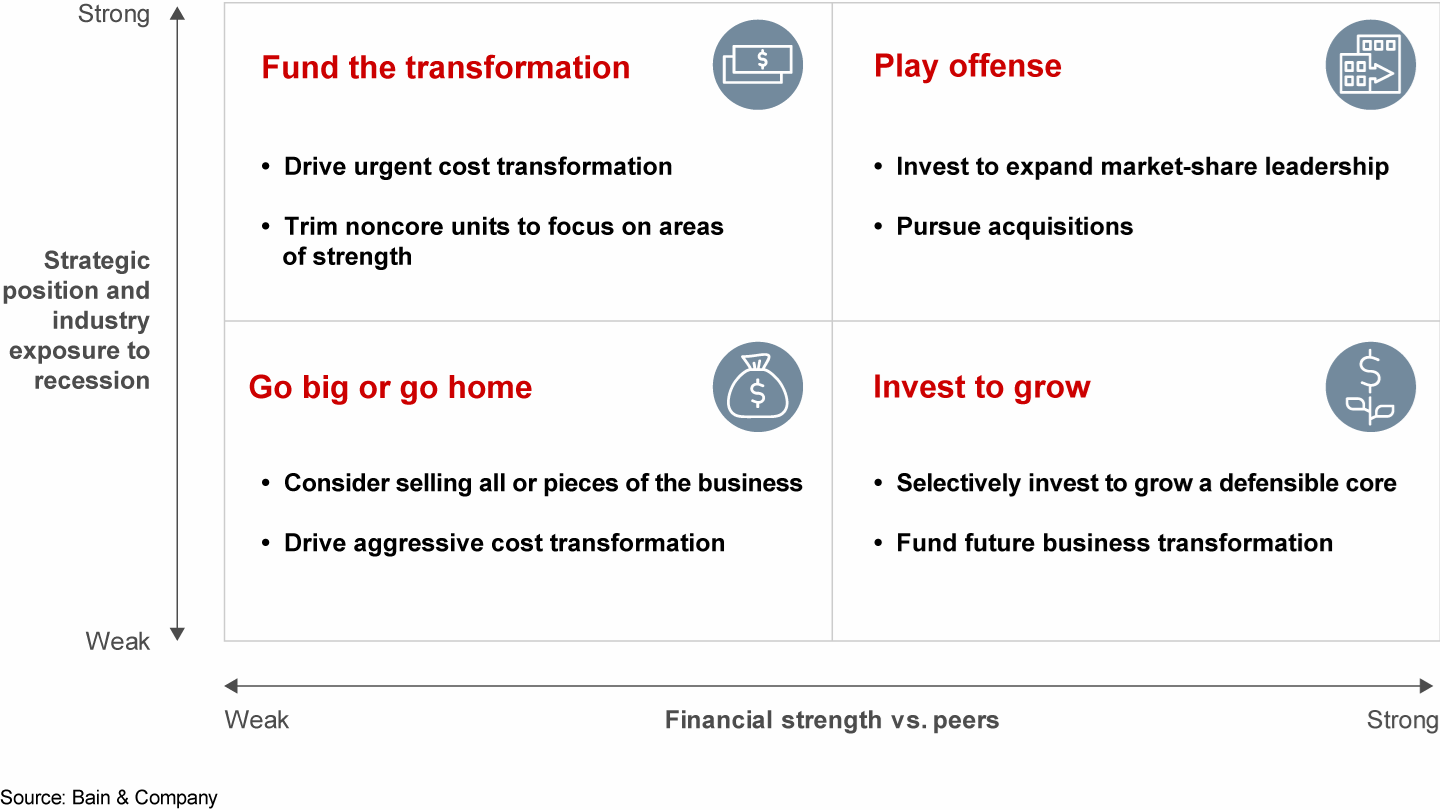
Investors in Amdel Ltd., a global mineral-testing company based in Australia, reaped a windfall by helping the company play offense in the downturn. In December 2005, CHAMP Ventures sponsored a management buyout of Amdel from Healthscope, investing $45 million. The fund’s management team helped Amdel refocus on its core minerals business, investing more than $11 million to set up greenfield plants in South Australia and Queensland that increased capacity and upgraded information systems. CHAMP also backed three strategic acquisitions to consolidate Amdel’s position as a global leader in minerals and environmental testing.
At the same time, the company hired new talent in business development and finance. Those initiatives helped Amdel double revenue and increase earnings fourfold from 2006 to 2008, just as the global recession was hammering customers in many of its far-flung markets. In May 2008, as the global financial crisis spread, Bureau Veritas, a global test and inspection company, acquired Amdel for $461 million. The exit produced a tenfold return on CHAMP Ventures’ investment and an internal rate of return greater than 160%, according to Asia Venture Capital Journal.
Navis Capital Partners achieved a stellar return on its investment in Linatex Rubber Products by deploying a “ride-the-wave” strategy, reinforcing its core business to improve performance, strengthening customer loyalty and making strategic acquisitions. In 2005, when Navis acquired Linatex, a subsidiary of Elementis that made rubber products for the mining industry, it had $55 million in sales and an operating margin of 0.4%. Elementis considered the business noncore.
Navis moved Linatex’s headquarters from the UK to Malaysia and made a series of strategic moves, including acquisitions in Chile and North America that broadened its offerings of complementary products. Linatex invested in a new low-cost manufacturing facility in Suzhou, China, and one in Santiago, expanding its global production and marketing footprint. That helped widen the installed base of products, increasing revenue from spares and consumables. Navis sold Linatex in June 2010 to the British engineering firm Weir Group for $200 million, generating a fivefold return on investment with an internal rate of return of 46%.
KKR and partners Silver Lake and Temasek used a full-speed-ahead strategy with analog semiconductor maker Avago Technologies (now Broadcom Inc.). KKR and Silver Lake acquired Avago from parent company Agilent for $2.6 billion in 2005, eying an opportunity for the chip division to thrive as an independent company. Following the carve-out, they established Avago Technologies in Singapore and partnered with the management team to design a more efficient operating model to design, develop and supply chips for industrial and consumer applications.
To accelerate growth, they hired a new CEO and strengthened the leadership team. It quickly refocused the business in core areas such as wireless fiber optics and networking. Avago divested noncore assets and pursued strategic acquisitions, including the fiber optics business of Germany-based Infineon Technologies. From 2007 to 2010, Avago’s revenue increased an average of 11% a year, while net income swung from a $159 million loss to a $415 million profit. In August 2009, Avago was listed on the Nasdaq stock exchange. By 2011, KKR, Silver Lake Partners and Temasek had effectively exited with five times cash-on-cash returns.
What to expect next
The global economy is likely to undergo a major transformation in the 2020s as the underlying macroeconomic trends that fueled the long-running expansion of the past decade dissipate and powerful forces reshape the business environment. In addition to a structural downturn, investors will need to grapple with ongoing economic, social and technological change in domestic and global markets.
A growing number of trade disputes and Brexit may significantly erode the easy access to global markets on which companies have based their global supply chains and growth strategies for decades. At the same time, rising pressure on businesses to reduce their carbon footprints may encourage some to revert to a business model built around local sourcing, manufacturing and customers.
In developed countries, labor and talent will become scarce in the coming decade, a sharp reversal of the trend of rapidly expanding global talent pools over the past 70 years. Shifting demographics, combined with technological and social changes, are likely to produce a labor squeeze in many parts of the world in the 2020s—especially for industries seeking highly skilled workers.
Additional disruptions loom on the horizon. Although they aren’t an immediate concern for most Asia-Pacific GPs, they may require leadership teams to rethink their strategies and investments in the coming decade. Potential future disruptions include destructive weather patterns and rising sea levels stemming from climate change and the exhaustion of natural resources, including oil, soils, fresh water and fish. These challenges will put governments under severe pressure to find innovative solutions.
Successful private equity funds will cope with rising volatility by taking a much more structured approach to understanding disruption in their industries. They’ll help portfolio companies look beyond traditional targets and goals and develop the ability to adjust to a changing macroeconomic environment. That may include developing new performance metrics, planning techniques and even organizational structures. Companies that can absorb shocks and change course quickly will have the best chance of surviving in more turbulent times.
Technology sector: Investors change course
Asia’s Internet and tech surge
Investors have channeled a growing pool of capital to Asia-Pacific’s burgeoning Internet and technology sector for nearly a decade. Over the last five years, the growth in deal value for these assets has far outpaced that in all other industries (see Figure 3.11).
Growth in Asia-Pacific Internet and technology investments has outpaced other sectors

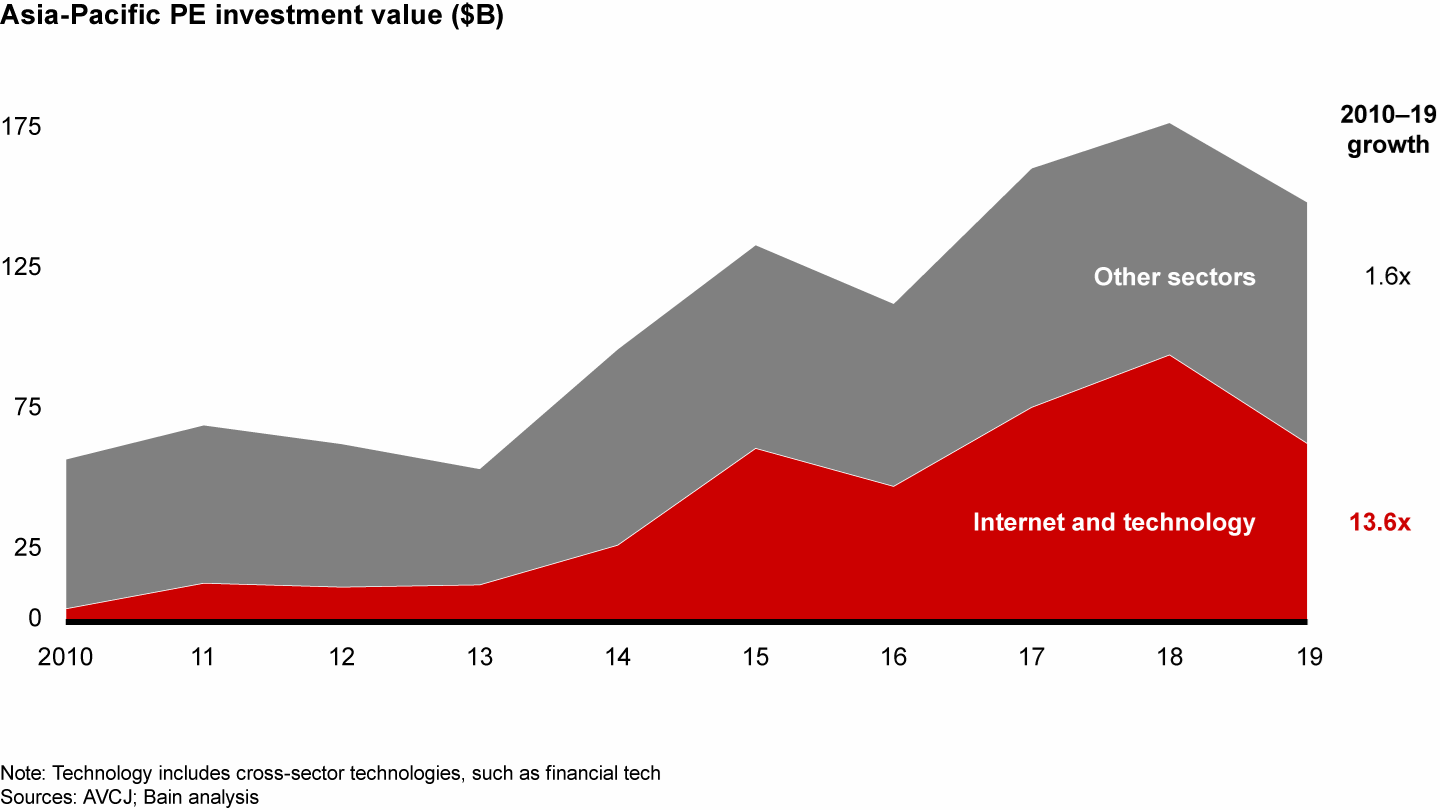
The sector’s allure may sound familiar, but Asia-Pacific Internet and tech assets are distinct, and they’re evolving rapidly. Beneath the top-line numbers, a geographical shift is underway. China has historically been the largest market, generating on average 70% of Internet and tech deal value from 2014 to 2018. China’s booming new economy was fueled by government initiatives that support domestic innovation, the arrival of leading international tech firms in China, and strong consumer demand for tech products and services. However, in 2019, China’s share of Asia-Pacific Internet and tech deal value fell to 48%, partly due to the decline in renminbi-based fund-raising since 2018. Investors also were put off in part by broad macroeconomic uncertainties and soaring prices for Internet and tech companies.
India’s vibrant Internet and tech sector, the second-biggest in the region, has been expanding rapidly, fueled by abundant access to venture capital, ample dry powder, growing Internet penetration, falling prices for data and innovative start-ups. In 2019, India’s Internet and tech sector represented 28% of the Asia-Pacific market, twice its share in 2015. Other parts of the region also have spawned robust tech sectors, notably Southeast Asia (see Figure 3.12).
China has propelled investments in Internet and technology until now, but India is gaining ground

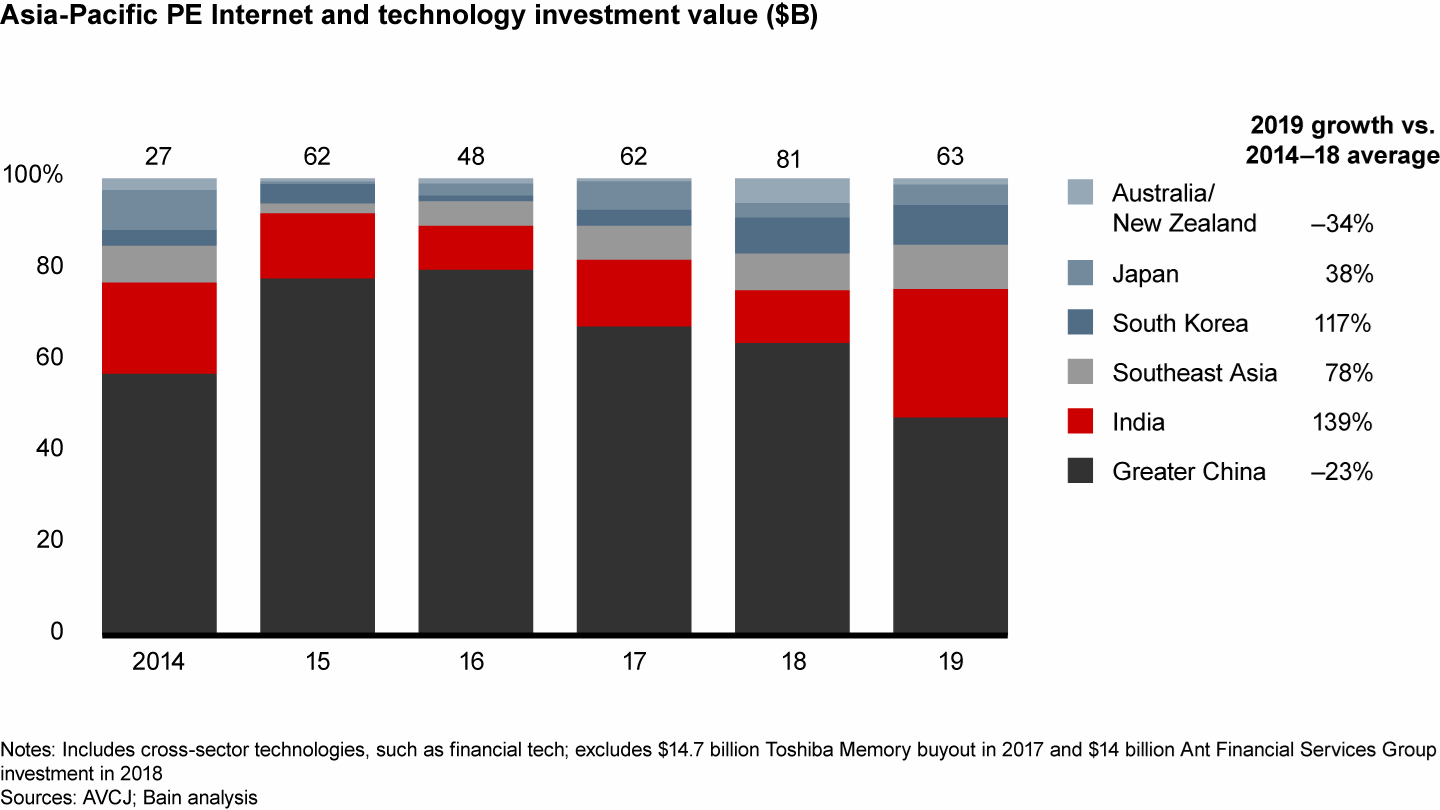
What’s more, Internet and tech companies in the Asia-Pacific region often take different paths to success than in the West. Why? Those that copy successful Western business models are unlikely to thrive without significant adaptation to local markets. In Southeast Asia, for example, ride-hailing service Grab outpaced Uber, the original disruptor, by adapting the service to the needs of drivers and riders in Indonesia, Vietnam and Thailand. Grab’s leadership team understood, for example, that most transportation takes place on motorcycles, rickshaws and tricycles in these countries, and it offered these vehicles in addition to cars. It also allowed cash payments instead of Uber’s credit card-only service, designed local marketing with rapid incentives and rewards, and invested in better mapping for drivers to improve accuracy of pick-ups and drop-offs. Uber eventually followed suit with a motorbike offering and other initiatives, but it could never become a dominant player in the region’s ride-hailing market. Uber left Southeast Asia after it was bought out by Grab in 2018.
The appeal of next-generation technologies
Until recently, investing in the new economy meant acquiring e-commerce, B2C online services or traditional software companies. Since 2014, however, GPs have been shifting their focus increasingly to next-generation technologies such as cloud-based software (also called software as a service, or SaaS), artificial intelligence (AI) and cross-sector technologies such as financial tech (fintech) or health tech (see Figure 3.13).
Next-generation technologies are the fastest-growing Internet and technology segment in the region

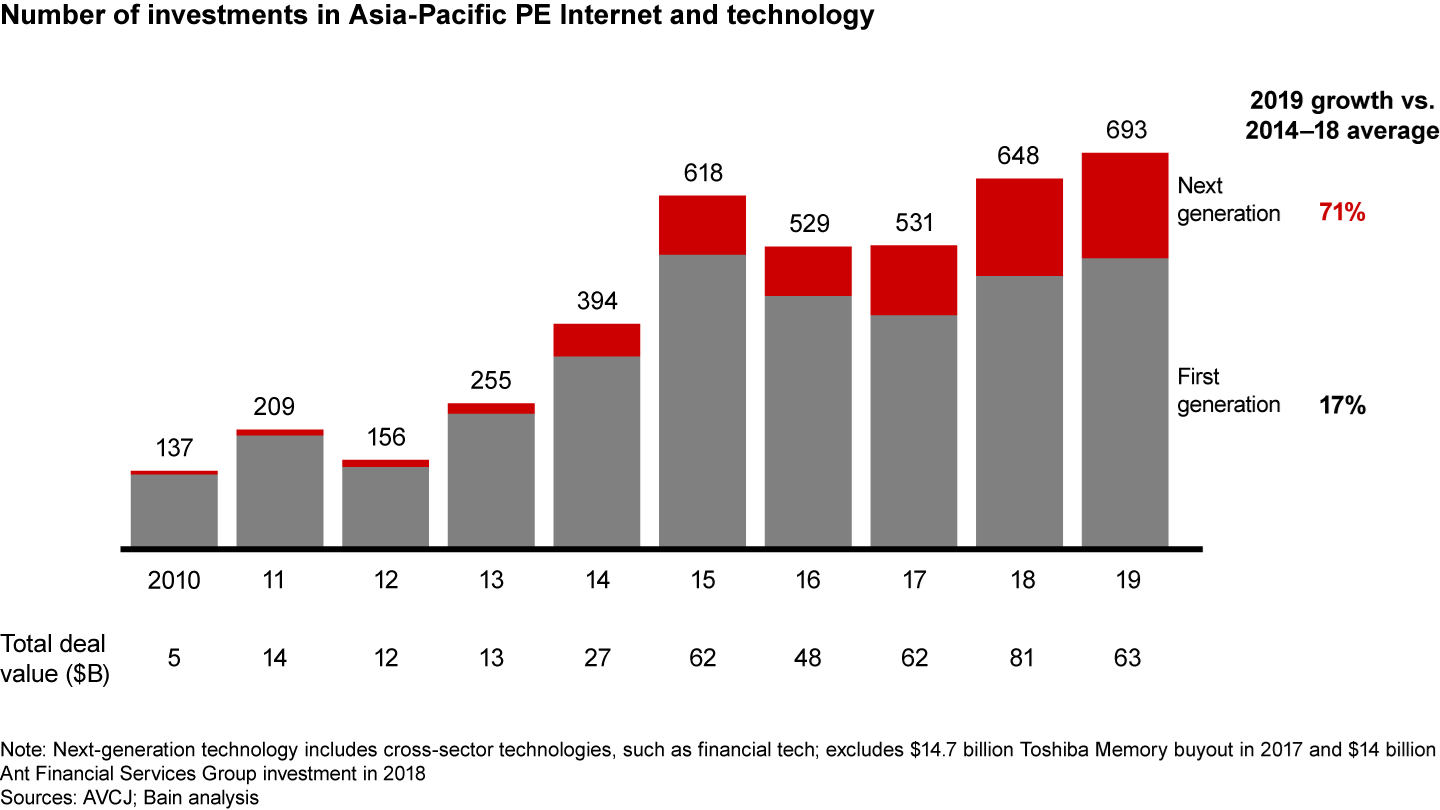
Second-generation technologies already are disrupting traditional industries. For instance, chatbots—robots powered by AI—are transforming the phone-based call-center industry. SaaS offers lower-cost software that can be updated over the Internet, sparing companies a steep up-front investment. The pricing model, based on usage, makes SaaS attractive to both large and small enterprises. The demand for SaaS and artificial intelligence has increased significantly over the past five years (see Figure 3.14). Investors are drawn to the powerful growth potential of these two sectors, the opportunity to scale businesses quickly, and the stable recurring revenue streams.
Cross-sector technologies, artificial intelligence and SaaS are fueling investment in the next-generation Internet and tech sector

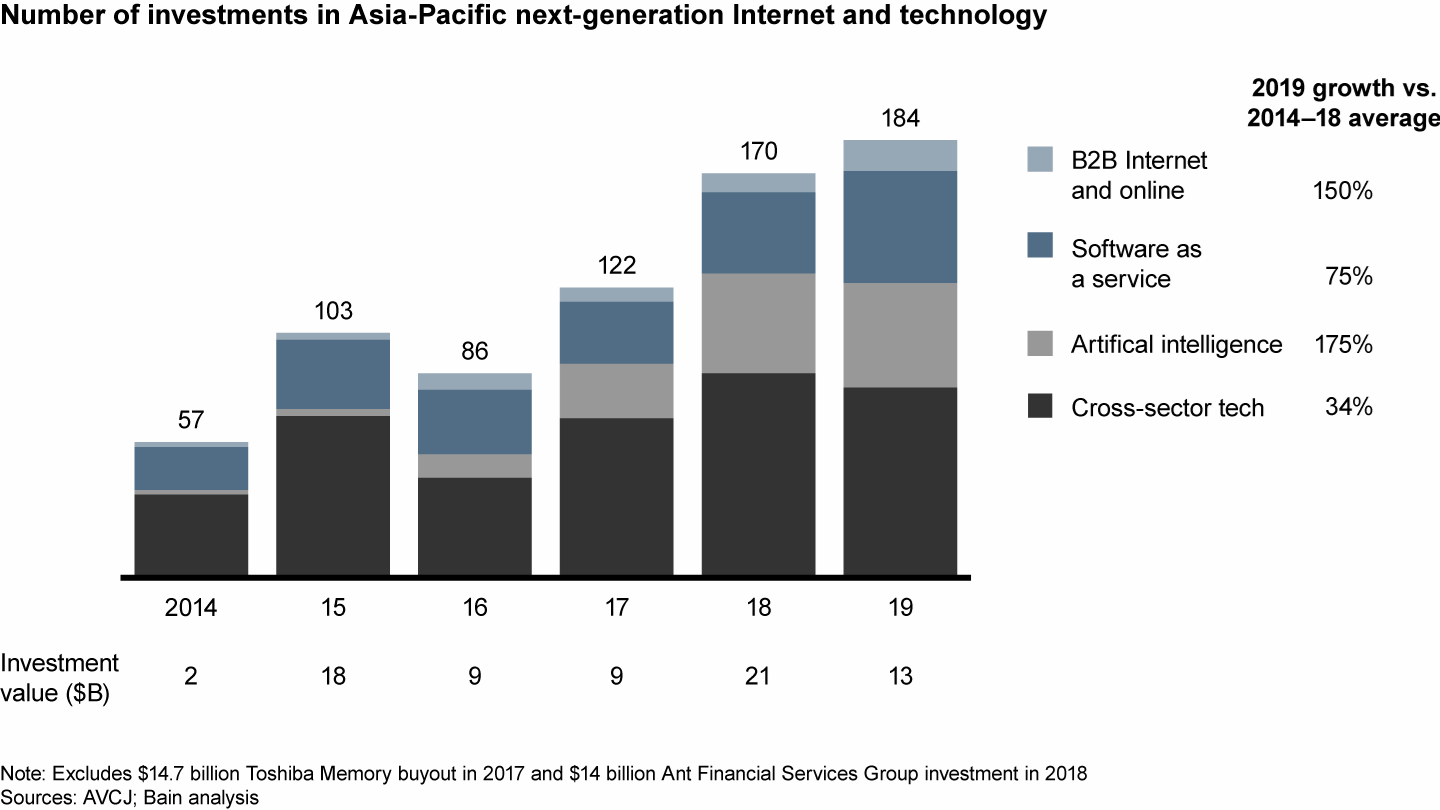
Though the number of next-generation Internet and tech deals rose in the region, deal value declined by 37%, primarily due to China, where deal value dropped 69%, even excluding the $14 billion Ant Financial Services megadeal in 2018. Overall, big transactions in Greater China were rare in 2019: The number of next-generation Internet and tech deals over $500 million fell to 2 from 10 in 2018.
Despite the dip in deal value, GPs tell us they plan to invest heavily in the coming three to five years, notably in SaaS (see Figure 3.15). For now, investment in artificial intelligence products, platforms and services is still growing, and 33% of GPs say they’re interested in this subsector. However, because AI is at an earlier stage of development, most deals in this subsector over the past five years were under $50 million.
Most Asia-Pacific PE funds plan to invest in SaaS, B2B tech, IT services, e-commerce and cross-sector technologies

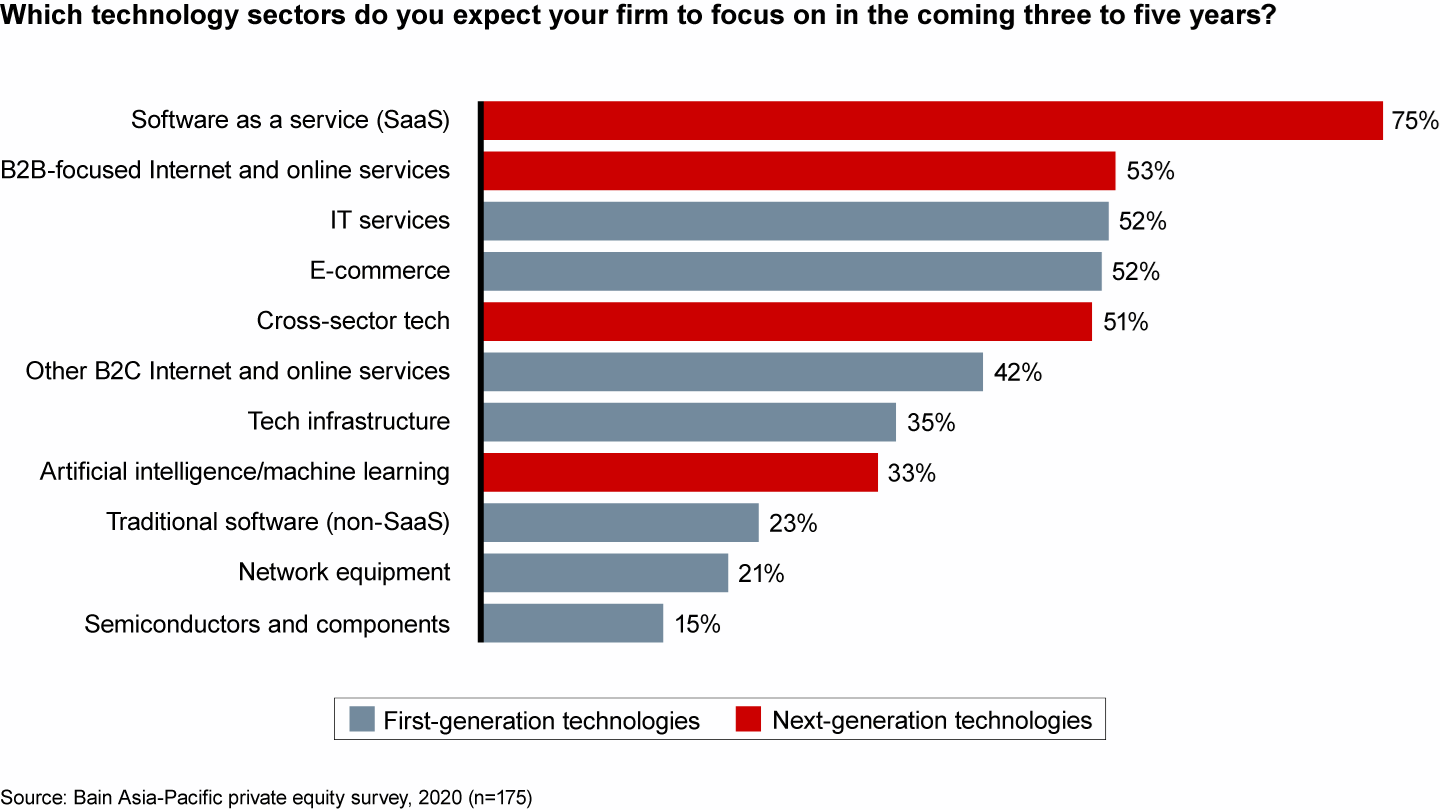
Next-generation technologies are creating new and exciting vehicles for private equity investors to transform business models and spur rapid growth. However, understanding the dynamics behind each of these subsectors is key to making smart bets. Below we’ll examine the capabilities needed to pick assets wisely and learn from the companies that are making successful investments.
SaaS soars
As companies race to harness big data, advanced analytics and machine learning, they’re turning to software on demand, based in the cloud. The global market for software as a service exploded over the past decade and nearly doubled in the past five years to $140 billion, but parts of the Asia-Pacific market developed more slowly because high-speed Internet infrastructure wasn’t widely available. Now, with increasing access to critical infrastructure, Asia-Pacific is giving rise to a growing number of agile SaaS companies offering software applications. Their solutions are centrally hosted in large data centers and available to customers via cloud computing, typically on a subscription basis. Investors are drawn to India’s SaaS sector, in particular, for its strong exports, particularly to small and medium-sized US businesses.
SaaS offers businesses big advantages over first-generation software systems hosted on a company’s server: minimal up-front capital investment, automatic access to the latest version of the software, less time spent keeping up with new types of hardware, and simple integration with existing systems or platforms. Investors love the stable recurring revenue streams and the ability to rapidly scale businesses to serve a wide range of customers in multiple industries. At the same time, the fixed costs for SaaS companies are lower than for traditional software firms. Given that many industries in the Asia-Pacific region are fragmented or offline, SaaS can help leapfrog legacy software systems into the 21st century and produce a jolt of efficiency.
China’s market for SaaS investment is the largest, but India is gaining ground. From 2015 to 2019, Asia-Pacific PE funds channeled an average of 84% of all SaaS investments to China, though it slipped to 65% in 2019. By comparison, India accounted for 15% of total deal value in 2019, nearly double the five-year average of 8%. Reliance Jio Infocomm Ltd.’s entry into India’s broadband market in 2016 expanded access to low-cost data, helping fuel fast-paced growth in SaaS investment and expand the country’s thriving SaaS ecosystem. Low costs, a broad array of applications and high-quality service also have boosted SaaS exports, increasing their appeal to global investors. US-based hedge fund Tiger Global and venture capital companies Sequoia Capital and Accel have been among the most active private equity and venture investors in India, focusing particularly on B2B technology companies such as SaaS firms. In the past two years, the three have invested more than $400 million in India’s SaaS sector.
Cross-sector technologies
Companies that deploy new technologies in existing industries can create fast-growing start-ups based on new business models. Health tech leaders, for example, are building wearable devices that monitor patients remotely. Fintechs have developed mobile payment systems and stock-trading apps that disrupt traditional financial services. Think about the last time you paid for something online. A digital payment system that bypassed the bank probably helped you complete the transaction. Similarly, marketing tech start-ups are harnessing web analytics to give sales a jolt.
Asia-Pacific-focused PE funds in search of disruptive products and services are betting on what we call cross-sector technologies. The number of deals in cross-sector tech companies in 2019 was a third higher than the prior five-year average. These technologies are attractive because companies can scale them rapidly, create broad product ecosystems that boost profitability, and in some cases, disrupt entire industries. And as Asia-Pacific consumers’ demand for digital services increases, so will the demand for cross-sector technologies.
As with many emerging tech companies, many of those developing cross-sector solutions aren’t yet profitable. Successful PE firms choose an investment strategy that provides the quickest path to profitability. One option is developing the core business model into an array of related offerings. Another approach is to disrupt a traditional industry process or solution. Digital payment systems, for example, aim to be smoother and easier to deploy than bank-based systems. Cross-tech companies may also pursue diversification and disruption simultaneously.
Ant Financial, SoftBank Investment and others used a dual strategy with India’s mobile payment provider Paytm, which received investments of almost $5 billion over the past 10 years. In addition to developing disruptive mobile payments, the investor group saw the potential to expand beyond financial services by creating an ecosystem to cross-sell other profitable products and services.
General Atlantic, Arpwood Capital and Lyra also pursued a specialization strategy from 2017 to 2019, when they invested $500 million in India’s Karvy Fintech to help broaden its offering to multiple financial industry subsectors while expanding throughout Southeast Asia. Now rebranded as KFintech, the company acts as a registrar and transfer agent for mutual funds and as a central record-keeping agency for India’s National Pension System.
Artificial intelligence
Global investment in AI start-ups has grown exponentially over the past few years, flowing into applications such as robotic process automation, machine learning, speech understanding and computer vision. AI is hot in the Asia-Pacific region, too. Artificial intelligence technologies make up the fastest-growing sector for investments among our second-generation Internet and tech grouping. Measured by deal count, AI investments grew 175% and deal value by 87%, compared with the prior five-year averages. Most deals were small, with 91% valued at less than $50 million, a sign that the industry is in its infancy.
Investors lured by AI’s growth potential also see the opportunity to disrupt or reinvent whole industries. Investors can maximize revenue growth and profit by expanding AI-based companies into adjacent fields or building ecosystems of products and services, similar to the approach leading funds are taking with cross-sector technologies. In 2018, Sequoia Capital and other investors provided an additional $145 million to 4Paradigm, a Chinese-based machine-learning platform initially focused on antifraud and targeted-marketing solutions. The company set itself apart from AI rivals by securing large-scale customers and focusing on profitability instead of breakthrough technology. Investors see significant growth potential in broadening 4Paradigm’s solutions and expanding into the finance, insurance and securities industries.
As with cross-sector technologies, the challenge is making bets at an early stage. Funds are shifting investment from broad, cross-industry AI applications to more industry-specific solutions that offer greater profit potential. Over the last five years, investors including Qiming Venture Partners, China Growth Capital, CBC Capital, IDG Capital and Temasek invested $245 million in Tongdun Science, a Chinese company harnessing AI for risk management. The company’s core business was providing antitheft and fraud-management software for financial companies eager to serve China’s booming peer-to-peer lending industry. Since less than 25% of the country’s population had a documented credit history when Tongdun Science was founded in 2012, the company had a huge potential market. And investors were betting it could attain even greater scale by expanding into such emerging markets as Indonesia, the Philippines and Vietnam, and such sectors as insurance and online gaming.
Warning signals for tech
Although the sector’s growth characteristics are alluring, the risk of a market correction among the most inflated Internet and tech assets has grown more acute over the past 12 months. We pointed to several key warning signs in last year’s report: A crush of investors chasing deals and pushing prices ever higher; a slowdown in exits, leaving funds with an overhang of assets; and a weak market for IPOs, which often resulted in a decline in market capitalization after the listing. These trends continued in 2019, making it more important than ever for investors to pressure-test their value-creation plans during due diligence and place their bets carefully.
The biggest challenge for investors is the region’s record-high Internet and tech deal valuations. For Asia-Pacific next-generation Internet and technology deals, the median enterprise value-to-EBITDA multiple from 2017 to 2019 jumped to 26, which was 95% higher than the previous three years. First-generation technologies’ deal multiple increased by 24% to 14. During that period, other sectors increased only 6.6% (see Figure 3.16).
Multiples for next-generation Internet and technology M&A deals rose to record highs

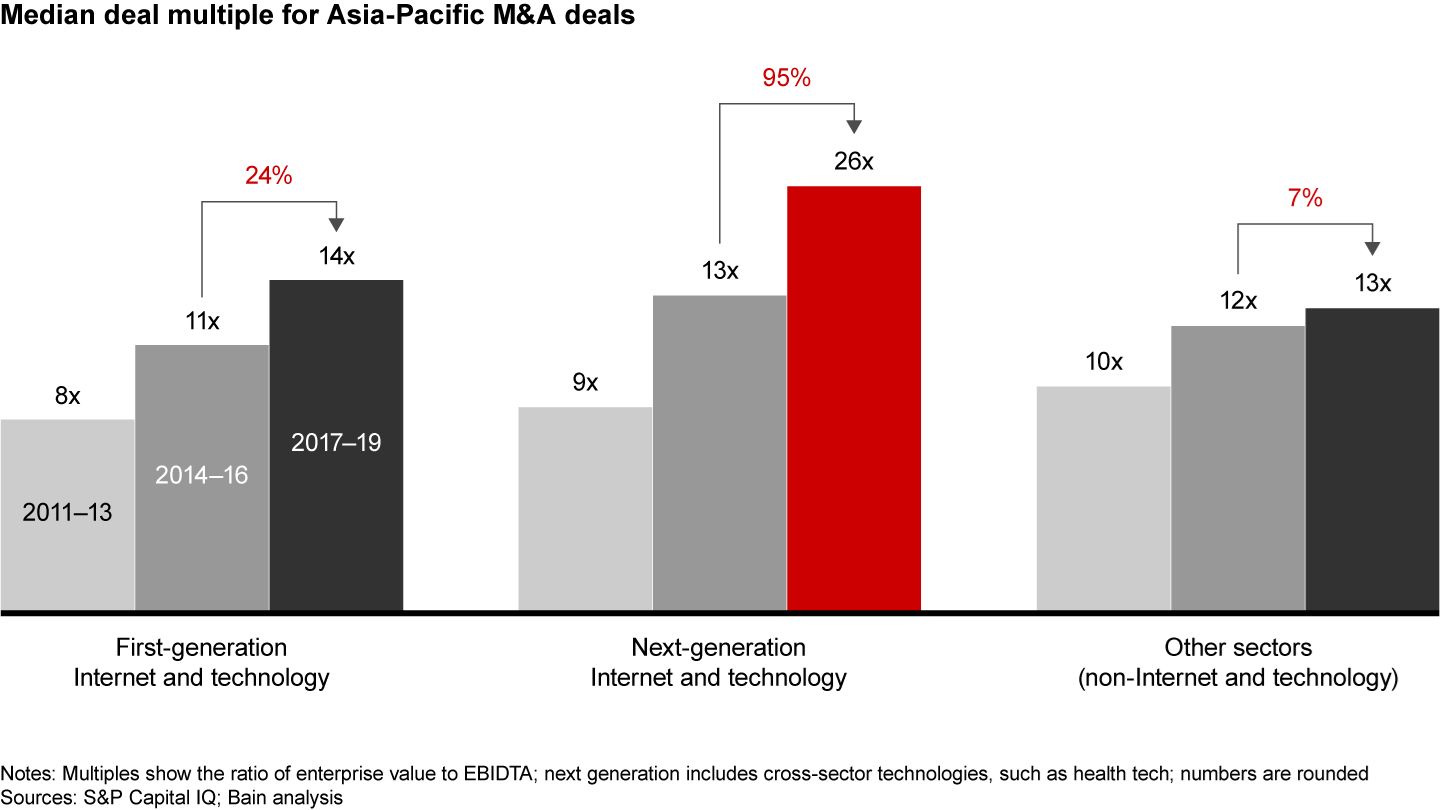
Dealmaking slowed in 2019, despite a growing number of options in the sector. Internet and tech deal value totaled $63 billion, a 22% drop from the previous year, even after excluding the $14 billion fintech megadeal by Ant Financial. And the sector’s share of the Asia-Pacific PE market declined for the first time in five years, to 42% from 49% in 2018 (see Figure 3.17). The sharp fall in China’s PE market, partly led by a slowdown in renminbi fund-raising, was a major reason for the decline. On the plus side, deal value in India rose 90%. One sign of the country’s increasingly robust Internet and tech sector: Since 2013 India has created more than 20 unicorns—young companies valued at $1 billion or more.
Investment in the Asia-Pacific Internet and technology sector declined, especially in China

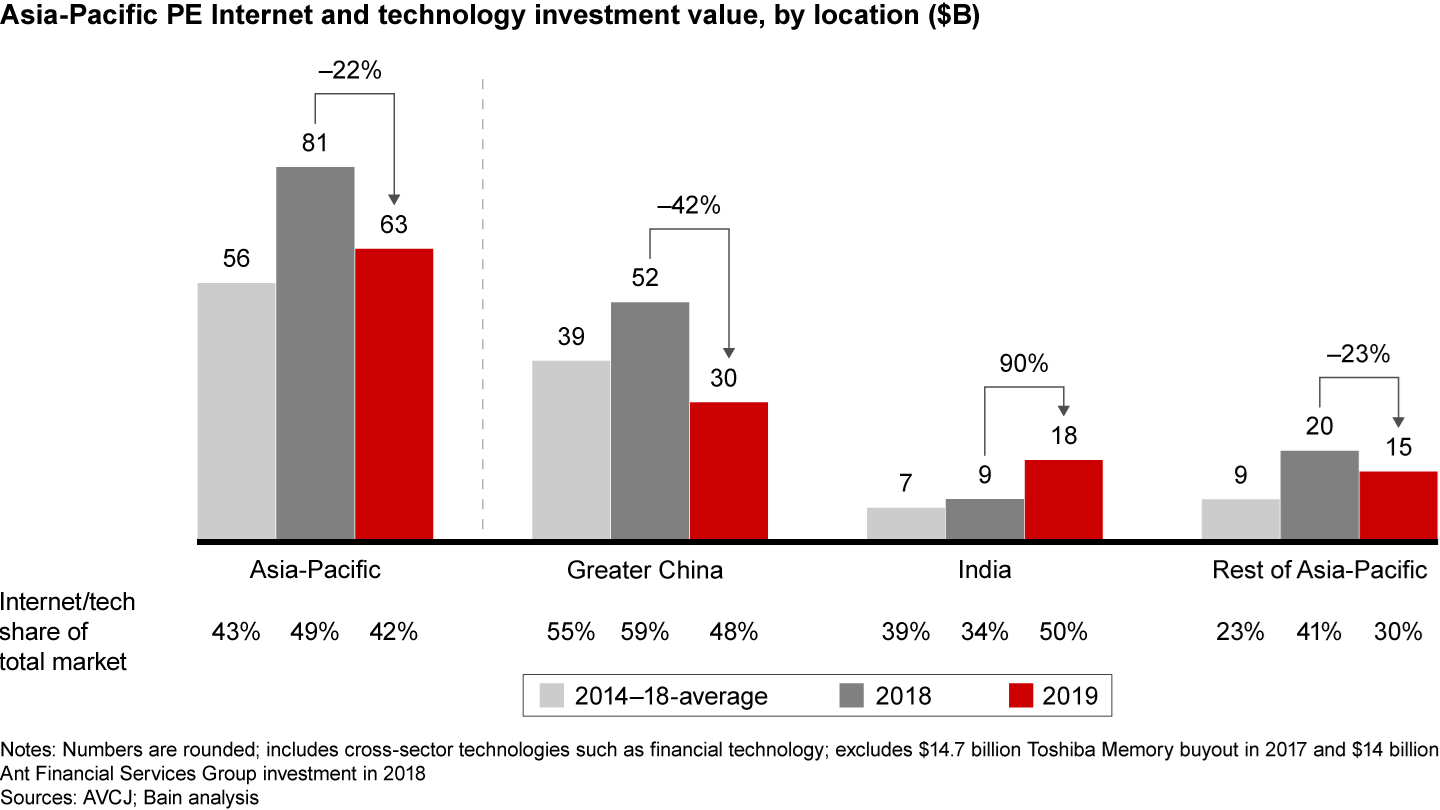
The majority of investors are worried the overheated Internet and tech sector will suffer a sharp correction. Nearly all expect a correction in the next two years, and one in six thinks the speculative bubble will burst in the next 12 months.
The warning signals that we flagged last year for the Asia-Pacific Internet and tech sector continue to flash red. The exit overhang is building, and return multiples fell by half to a median of 2.0 from 2017 to 2019, compared with 4.0 for investments exited the previous three years (see Figure 3.18). And return multiples have been trending downward for several years: 80% of deals from 2017 to 2019 had multiples of less than 4, compared with 51% from 2014 to 2016. Another worrying sign: 33% of companies that went public in the past two years lost 30% of their value, compared with only 12% in 2016 and 2017. The negative IPO results have stoked uncertainty among investors. A fifth of GPs say poor IPO outcomes have significantly influenced their planned holding periods and expected returns.
Warning signals are flashing for the Asia-Pacific Internet and technology sector

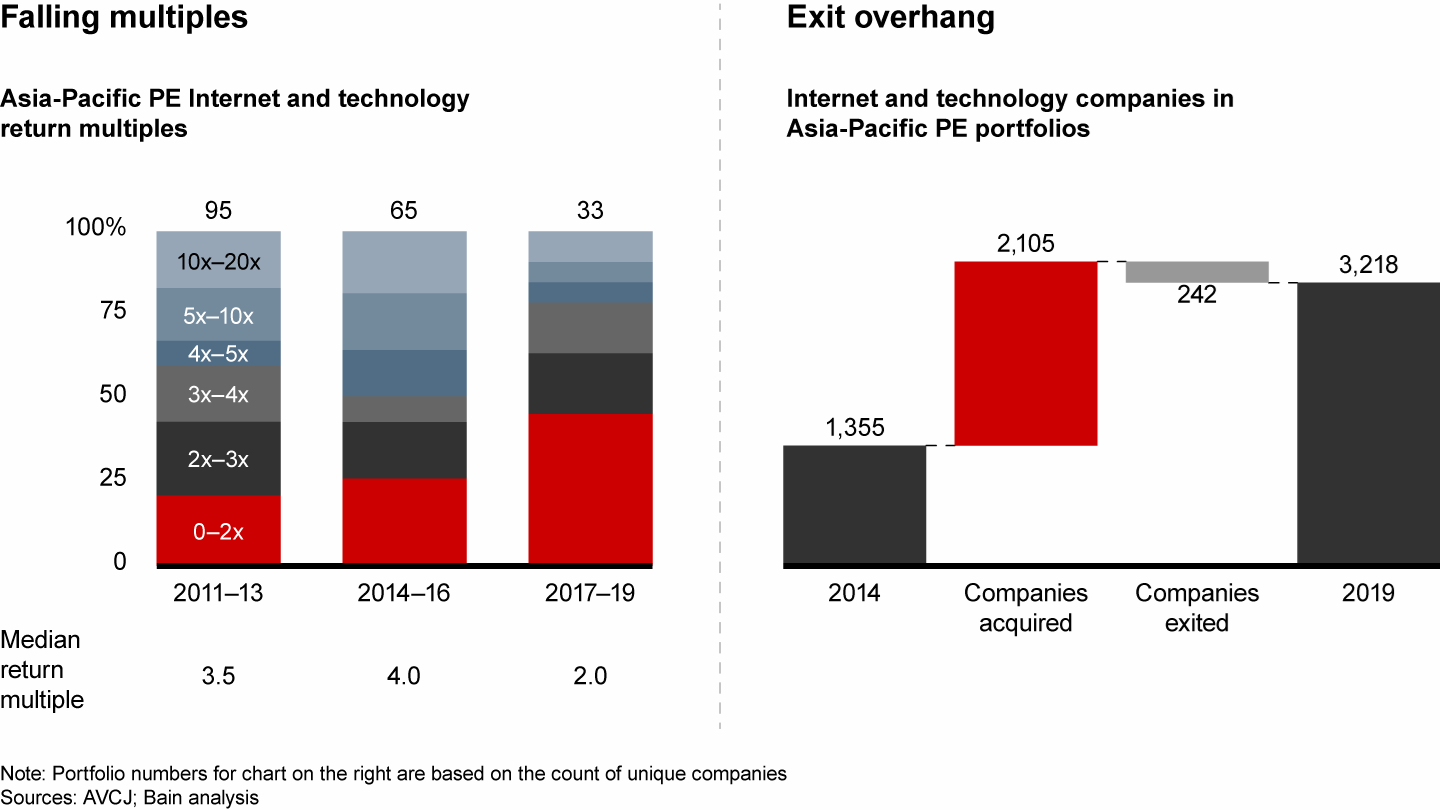
At the same time, 90% of PE firms continue to say it’s difficult to evaluate companies in the new economy, due to high prices (63%), inability to rely on traditional PE valuation techniques (62%) and difficulty justifying investments in loss-making businesses (48%). Only 3% of PE firms say they have a proven model to successfully source, evaluate risks or add value to new economy assets (see Figure 3.19).
Few Asia-Pacific PE firms have fully developed capabilities for investing in Internet and technology companies

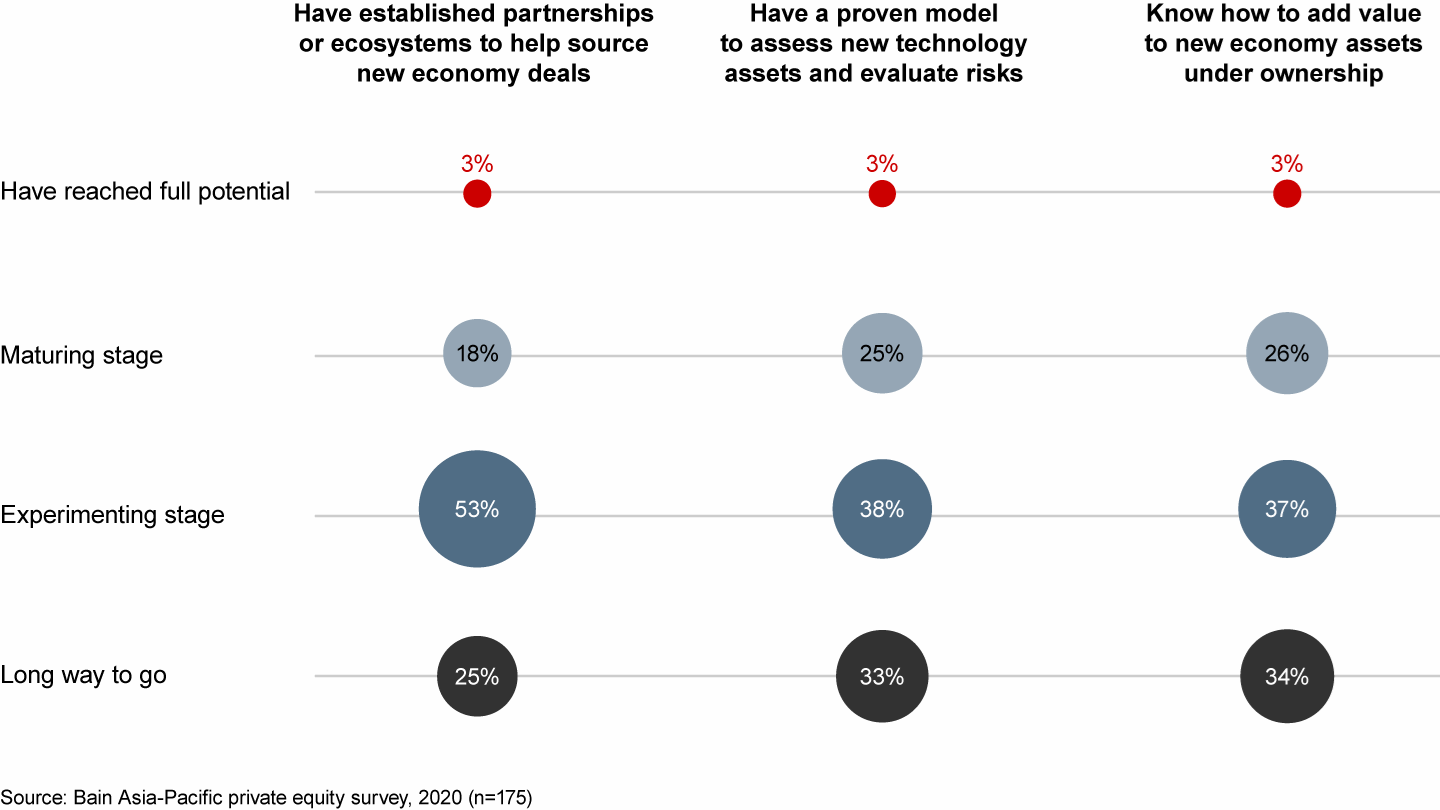
As clear as the risks are, technology and the Internet continue to attract large piles of capital. Although 2019 marked a slowdown, our research shows that a majority of PE firms in the Asia-Pacific region plan to invest in the Internet and tech sector. Sixty-two percent say they have new economy deals on their radar, and 19% consider this a core part of their mandate. What gives them confidence that they can beat excessive valuations? Or put differently, what can investors learn from best practices that would help them sharpen their own investment model?
Winning in Internet and tech
In our experience, PE firms that invest successfully in the Internet and technology sector have four common characteristics: An experienced Internet and tech deal team, strong partnerships, a tailored approach to assessing each technology and a strong focus on the path to monetization. Let’s take a closer look at PE firms that highlight each of these traits.
- Experienced and dedicated sector deal team. Leading PE firms develop a deep understanding of the Internet and tech landscape, building dedicated subsector teams, for example in B2B or B2C, to evaluate deals. That’s probably easier said than done. And not everybody can strive to be like Sequoia Capital or Tiger Global, which have invested heavily in technology in recent years. But to build proficiency, funds can start by hiring experts from tech companies like Twitter or Google, as TPG and KKR did. They also can coinvest with top tech funds to limit risk and increase their know-how.
- Strong partnerships with companies immersed in new economy innovations. Partnerships can provide access to complementary skills, knowledge and networks, and expedite the search for best-in-class companies and help management teams maximize value. In exchange, these partnering firms can benefit from capital and leverage PE funds’ ability to accelerate value creation.
Take the example of TPG’s 2018 partnership with SoftBank Ventures Asia (formerly SoftBank Ventures Korea) to invest in a $300 million China fund for Internet and tech start-ups. TPG Growth is widely known for its investments in prominent technology start-ups such as Uber and Spotify. But this vehicle gives TPG access to SoftBank’s Chinese network, including local expertise in sectors like artificial intelligence, fintech, e-commerce and B2C online services. Since its launch, the joint fund has made three investments in Chinese companies in e-commerce, SaaS and B2C online services. - A tailored approach to assessing each technology. Top-performing new economy funds recognize that technologies vary widely, and they identify the factors that contribute to a winning deal for each one. For example, successful SaaS companies share four criteria: established proof of concept and robust growth, a diverse and stable customer base with low churn, strong customer feedback and high barriers to switching, and a high degree of product standardization.
- A strong focus on the path to profitability and unit economics. Investors are cautious about investing in cutting-edge technologies that don’t have immediate commercial applications or a path to profitability. Sixty-one percent say understanding how a company will generate revenues from new technologies is a priority when evaluating new economy deals. Many want to see projected cash flow and profitability, and to understand the direct revenues and costs associated with a target’s business model, expressed on a per-unit basis.
To ensure that prospective management teams focus on the bottom line, GPs can pressure-test their value-creation plan during due diligence. One global PE fund built an early view of value-creation opportunities for a software target. The exercise revealed that the target’s marketing capability was critical to future growth, but lacked the digital expertise to generate it. The exercise also revealed questions about spending on digital marketing. The PE fund and the diligence team launched a benchmarking effort to create a list of digital marketing projects, such as improving the website experience, and estimate the potential value creation. That effort assured the PE fund that the company’s revenue could increase significantly. Once the fund bought the company, the investment in digital marketing rapidly boosted revenue and helped reduce the cost of acquiring customers.
4. Conclusion
It was a mixed year for Asia-Pacific’s private equity investors. Investment in most markets grew or was stable, compared with the past five-year average. But the sharp decline in Greater China’s deal activity and exits pulled down the region’s overall performance and ended a boom that started in 2017. While a majority of the PE firms we surveyed remain positive about future market returns, an increasing cohort of GPs sense the market has begun a downward trajectory, and many see fewer attractive deals in the market. Nearly all investors are concerned about a possible global downturn and the potential disruption posed by increasing trade frictions. And with multiples at record highs at this late stage of the economic cycle, the risk of a global market correction is significant. But as we well know, periods of uncertainty also create opportunities.
Leading firms are taking steps to stormproof their portfolios and adjust their strategies, revisiting the lessons learned from previous recessions. That includes seeking greater control over deals and taking a more active approach to managing portfolio companies. Despite growing macroeconomic and regional risk, returns remain stable and investors continue to identify new growth sectors. In particular, GPs in the Asia-Pacific region are shifting their focus to next-generation Internet and tech companies. Funds that develop the skills to reduce their risk and increase opportunities in an uncertain business environment will be in a stronger position to navigate the decade ahead.
Market definition
The Asia-Pacific private equity market as defined for this report
Includes:
- Investments and exits with announced value of more than $10 million
- Investments and exits completed in the Asia-Pacific region: Greater China (China, Taiwan and Hong Kong), India, Japan, South Korea, Australia, New Zealand, Southeast Asia (Singapore, Indonesia, Malaysia, Thailand, Vietnam, Philippines, Laos, Cambodia, Brunei and Myanmar) and other countries in the region
- Investments that have closed and those at the agreement-in-principle or definitive agreement stage
Excludes:
- Franchise funding, seed and R&D deals
- Any non-PE, non-VC deals (e.g., M&A, consolidations)
- Real estate and infrastructure (e.g., airport, railroad, highway and street construction; heavy construction; ports and containers; and other transport infrastructure)
The Internet and technology sector as defined for this report
- Includes e-commerce, consumer electronics, B2C and B2B Internet products and online services, IT services, semiconductors and components, Internet infrastructure and networking, software as a service (SaaS), information technology services, artificial intelligence products, blockchain and others
Acknowledgments
This report was prepared by Kiki Yang, a Bain & Company partner based in Hong Kong, who coleads the firm’s Asia-Pacific Private Equity practice; Sriwatsan Krishnan, a partner based in Mumbai; and Johanne Dessard, practice director with Bain’s Private Equity practice.
The authors wish to thank Andrea Campagnoli, Kelly Pu and Lalit Reddy for their perspectives on technology and Internet investing; Usman Akhtar, Vinit Bhatia, Alex Boulton, Wonpyo Choi, Arpan Sheth, Aditya Shukla, Michael Thorneman, Andrew Tymms and Jim Verbeeten for their input on regional dynamics; Joy McConnochie and Helen Saunders for their contributions; Rahul Singh, Shilpi Bansal, Brittany Hunter, Mark Lin and Nina Khoury for their analytic support and research assistance; and Gail Edmondson for her editorial support.
We are grateful to Preqin and Asia Venture Capital Journal (AVCJ) for the valuable data they provided and for their responsiveness.